






























































The Chartered Insurance Institute 20 Fenchurch Street, London EC3M 3BY
The Chartered Insurance Institute 20 Fenchurch Street, London EC3M 3BY
Tel: (020) 8989 8464
Tel: (020) 8989 8464
The Journal is online at www.thejournal.cii.co.uk
The Journal is online at www.thejournal.cii.co.uk
The Journal is the official magazine of the Chartered Insurance Institute (CII). Views expressed by contributors or advertisers are not necessarily those of the CII or the editorial team. The CII will accept no responsibility for any loss occasioned to any person acting or refraining from action as a result of the material included in this publication.
The Journal is the official magazine of the Chartered Insurance Institute (CII). Views expressed by contributors or advertisers are not necessarily those of the CII or the editorial team. The CII will accept no responsibility for any loss occasioned to any person acting or refraining from action as a result of the material included in this publication. CEO: Matthew Hill
The Journal is online at www.thejournal.cii.co.uk
Cover Image: Edited by Craig Zaduck
executive: Sian Fisher
EDITORIAL
Editor:
Editor: Luke Holloway (020) 7417 4778 luke.holloway@cii.co.uk
Contributing editor: Liz Booth
Senior Designer: Will Williams































The Insurance Institute of Kendal has a relatively small membership base: 270 members, split 186 in general insurance and 84 in financial services.
With that in mind, it’s impressive to note that the council has nine active members, one of whom is the current president of the CII nationally – Ian Callaghan. On the council, we are keen to maintain a range of experience and diversity of thought around the table. This helps us keep our offerings relevant without compromising our heritage.
In 2024, we will have a change of the guard, appointing Alice Wilkinson as my successor as president.
Alice has worked in both general insurance and financial services and is about to receive her Chartered financial planner qualification. Her focus for the year is on legacy planning, ensuring we have the right people in the right places to continue the work of our Institute. This includes training team members, as well as looking to recruit new ones.
OUR INSTITUTE PROVIDES A VALUABLE CENTRAL HUB FOR LIKEMINDED INSURANCE AND FINANCIAL SERVICES PROFESSIONALS
colleagues that they may otherwise not have met and develop their own skills around event planning, mindfulness, organisation and public speaking.
Our education outreach programme has also been gaining traction. We now have links with seven local schools and higher education facilities. We have run careers courses for each one and, better still, organised these as annual events. Last year we had nine courses, which led to two individual enquiries from students and we are even taking one of the T-level students as a trainee at the end of the year as a direct result of our work.
In the last two years, we have had an emphasis on returning to face-to-face events, including continuing professional development and technical learning as well as some non-traditional events too. We held our first equality, diversity and inclusion (EDI) event last month with a local training provider, highlighting the importance of EDI within the workplace.
Our Institute goes further than events to engage and support members; it has also offered each one of the council members opportunities to build networks, learn from
For me, our Institute provides a valuable central hub for likeminded insurance and financial services professionals. It is a safe space to discuss issues pertinent to each discipline as well as an opportunity to learn more about the CII’s direction and strategy to best communicate this to our members and community.
I truly hope our local institute continues to go from strength to strength as it is hugely beneficial for our members, especially given our location and the rural nature of our environment. It will be a pleasure to hand the reins over to Alice next month to take things forward. ●



 Roger Jackson is a Chartered financial planner and president of the Insurance Institute of Kendal
Roger Jackson is a Chartered financial planner and president of the Insurance Institute of Kendal
@johnnytimpson1
On World Autism Awareness Day 2024 #WAAD24 Anita Boniface and I dedicate our Journal article to neurodivergent people plus all with neurodivergent partners and/ or children who need workplace adjustments and support
@BIMTECHNoida
#BIMTECH is proud to announce a significant milestone – the inauguration of the @CIIGroup Accredited Centre at our campus
Matthew Hill officially began his role as chief executive of the CII Group in April.
Hill joins the CII from the Legal Services Board where he was chief executive, a position he held since August 2019. His background also includes spells with the General Dental Council and Gambling Commission, following more than 20 years in central government in a range of areas.
The CII is now continuing working towards the goals laid out in the 2023-2027 Strategic Plan.
Hill commented: “It is a great privilege to have been appointed as CEO of the CII Group. I have been very impressed by the CII’s very clear intent to provide first-rate sector leadership on behalf of its committed and passionate membership, and to deliver the highest professional standards for the benefit of public trust in the insurance, financial planning and mortgage advice professions. I will do everything I can to help it achieve those goals.”
@CommercialExp
We’re happy to share that we’ve officially received our Chartered Insurance Underwriting Agents Certificate! A huge thank you to the CII for their invaluable support on this remarkable journey

Data from the CII 2023 Corporate Chartered Equality Diversity & Inclusion (EDI) survey indicates positive business outcomes for firms implementing EDI practices and policies.
Respondents said practices such as ‘EDI training for colleagues that goes beyond compliance requirements’, ‘attracting talent from underrepresented groups’, and ‘systematically collecting diversity data’ have led to positive outcomes for their firms, including improvements in creativity and innovation, and increases in employee engagement levels.
The latest data shows an increase in the proportion of respondents saying that EDI policies had directly led to a ‘more representative workforce’ and a ‘more representative senior leadership team’. There is also an increase in the proportion of respondents reporting that EDI policies

have ‘raised awareness and understanding of EDI’ and ‘helped leaders identify biases’.
The most widely adopted EDI practices across firms were said to be ‘family and carer friendly policies’, with 87% of respondents saying their firm had implemented them to a ‘moderate or great extent’, a five percentage point increase
since 2021. Other widely adopted practices include ‘leaders role modelling an inclusive culture throughout the organisation’ (82%), ‘senior leaders being accountable for EDI, with responsibilities cascaded through all levels’ (77%), and ‘leaders supporting positive actions to address disadvantages faced by individuals with protected characteristics’ (71%).
The EDI survey data reinforces the recommendations made in the CII-sponsored Young Foundation EDI report, which found that nearly 75% of professionals had experienced ‘discriminatory or exclusionary’ workplace behaviour.
→ The CII has produced a range of resources to support diversity in the profession available here: www.cii.co.uk/about-us/ supporting-diversity-in-the-profession
@FMBInsurance
Say hello to Toby, an account support executive here at FMB Insurance. Toby’s looking forward to progressing through the CII ranks and improving his knowledge of the commercial sector
@NHBC Congratulations to the NHBC apprentices from our underwriting, claims, consumer affairs and data & analytics teams who have completed their apprenticeships with the @CIIGroup
@MacbethInsure
#TeamMacbeth were out in force at the Reading Institute dinner, in celebration of the local @CIIGroup. Congratulations to Stuart Adamson for picking up the Annual Achiever Award, a reflection of the topnotch service he gives our clients
@CIIGroup X (formerly Twitter)
20,190
Followers and counting...
CII company 109k followers
CII Group 50k+ members
The CII has launched a campaign to clarify the correct use of member designations.
A CII, Personal Finance Society (PFS) or Corporate Chartered designation or title is a significant achievement for an individual and a sign of professionalism. However, all designations and titles have strict rules governing their use.
It is important for insurance and personal finance professionals to be aware of the requirements to use a CII designation and also what to do if you suspect that someone is misusing a CII designation.
To use a CII designation, an individual must:
● Be an active member of the CII.
● Have met the qualification requirements for that particular designation.

The potential consequences of misusing a CII designation or Corporate Chartered title could involve legal action being taken against the infringer, therefore it is vital that members and students of the CII ensure they meet the requirements before using any CII designation, or if you are a firm, meet the eligibility criteria for Corporate Chartered status.
If you suspect that someone is misusing a CII designation or Corporate Chartered title, and thus infringing on the CII’s intellectual property rights, please contact the CII by emailing: customer.serv@cii.co.uk
→ For more information, visit: www.t.ly/d7y69
The CII Broking Community board will be hosting a fridge session at this year’s BIBA Conference at 1pm on 16 May.
The ‘Thriving in the evolving landscape of the insurance broker’ session will discuss the challenges and opportunities facing insurance brokers in 2024 and explore actionable strategies to navigate these challenges.
The panel will include Laura Hancock, managing director of Yutree Insurance and chair of CII Broking board, Charlie Upton, regional managing director, northeast at PIB
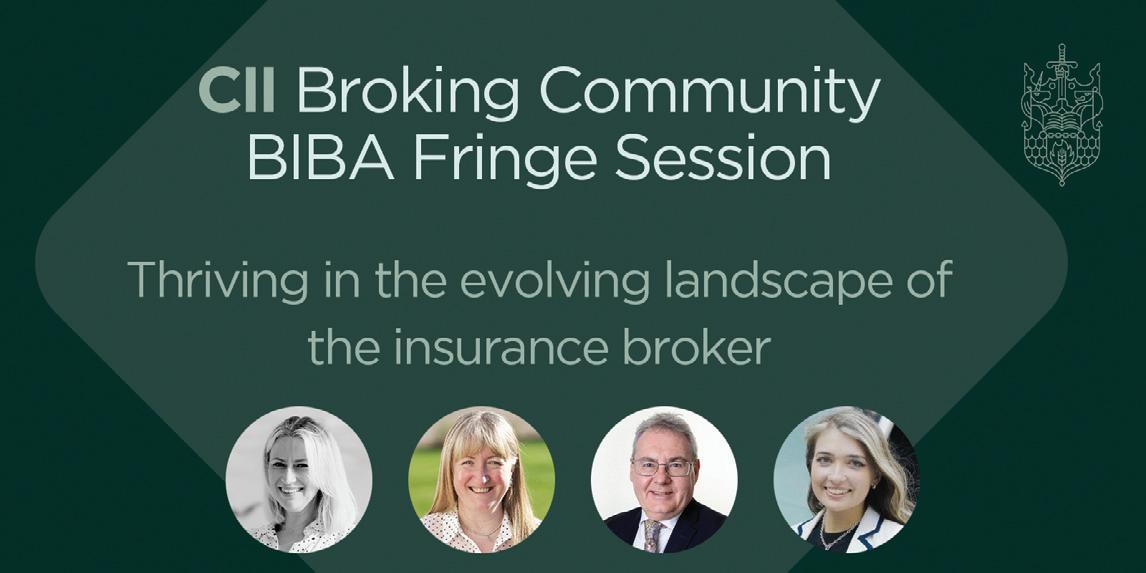
→ To find out more, visit: www.thebibaconference.org.uk
The CII and Personal Finance Society (PFS) Apprenticeship Awards 2024 are open for nominations.
The awards – launched last year –celebrate the hard work and successes of insurance and personal finance apprentices, their employers and the training providers.
There are seven Apprentice of the Year categories, including three for general insurance professionals, aimed at recognising apprentices who have made a real difference to their workplace and used a CII or PFS apprenticeship to boost their career.
There are also three Employer of the Year categories – one of which is open to apprenticeship providers – which recognise employers that have put CII and PFS apprenticeships at the heart of their business and reaped the benefits.

The award open to apprenticeship providers recognises employers and providers who can demonstrate their commitment in creating opportunities and support packages for disadvantaged and underrepresented groups.
The CII is introducing a new tutor-led virtual training programme covering the whole Certificate in Insurance qualification. Two separate cohorts will enable those following a broking pathway and those on an insurer pathway to learn alongside other students, via 10 half-day training courses spread over six months.
The insurer training programme will cover:
● IF1 Insurance Legal & Regulatory
● IF3 Insurance Underwriting Process
● IF4 Insurance Claims Handling Process.
The Broker Training Programme will cover:
● IF1 Insurance Legal & Regulatory
● IF2 General Insurance Business
● I10 Insurance Broking Fundamentals.
Shelly Bridgnell, CII learning propositions executive, commented: “Many students choose a trainer to help them prepare for their
→ For full details of the categories, more information and to nominate, visit: www.cii.co.uk/ careers-in-insurance/ aspire-apprenticeships/ apprenticeship-awards-2024

assessments, and there are many excellent trainers and firms to choose from, each with different materials and formats. This new training programme means students can study together on the same pathway, from start to finish of a whole qualification, helping each other and learning from the same expert tutor for all three units.”
→ The insurance pathway starts on 21 May 2024 and the broker pathway begins on 23 October 2024. For more information, visit: www.t.ly/lK0FE
The Journal Podcast series is now in its 12th season and invites industry experts to discuss an array of themes from across the insurance profession, as well as give CII members and the wider sector an insight into the work of the professional body.

This series features episodes covering a range of topics, including ‘Excelling at qualifications’, ‘The impact of traumatic claims’, ‘Volunteering on Local Institute councils’ and ‘Meet the new CII vice-presidents of international’.
The podcasts are hosted on The Journal website and are also available via SoundCloud, Stitcher Radio or Apple.
→ To listen to the latest season and access a complete library of previous episodes, visit: www.thejournal.cii.co.uk/podcasts
The CII has announced an in-person workshop, delivered over a half-day, which aims to support insurance professionals to develop soft skills and general awareness when dealing with clients in vulnerable circumstances.
The workshop will include a virtual reality experience, with case studies.
Suitable for all advisers, support teams and anyone in the insurance and financial services sectors who engages with customers and clients, the workshops will:
● Help you understand the needs of vulnerable clients.
● Increase your skills and capability for identifying and recording vulnerability.
● Increase empathy and soft skills.
● Learn to pre-empt foreseeable harm or client disadvantage.

● Give an overview of FCA vulnerability observations and Consumer Duty focus.
● Offer a vulnerability virtual reality roleplay and discussion.
● Offer a vulnerability case study including self-assessment.
The training workshop will be delivered face to face, over one half-day on 29 May 2024 or 20 June 2024, depending on demand.
→To find out more, visit: www.t.ly/VICJk




This is my first column in The Journal, having started as the CII Group’s new CEO in April – and it is a pleasure to be here.
I am extremely grateful for the warm welcome I have received from my new colleagues, alongside kind words from members and other stakeholders from across the insurance and personal finance professions who have been in touch during the last few weeks. It is clear from these early conversations that the CII is playing a significant role in a great many areas of critical importance to our professions, while there is scope to expand our contribution in others.
For example, building and maintaining public trust is at the heart of the CII’s mission. Our long-established and ongoing research into the drivers of confidence through our Public Trust Index helps firms understand what is, and is not, of relevance to consumers. In addition, our requirement for Corporate Chartered firms to have an equality, diversity and inclusion policy in place is driving positive outcomes for firms, including achieving improvements in creativity and innovation, and increasing levels of employee engagement. Furthermore, our range of school initiatives aimed at developing greater understanding of the insurance and personal finance professions, alongside our work experience, apprenticeships, T-Levels and flagship New Generation programme are creating opportunities for new talent to join and flourish in our sectors.
We are also part of active conversations that will have significant implications for the insurance sector over many years to come –including around sustainability and the adoption of AI. Indeed, in this edition of The Journal we are asking whether AI is actually benefitting the insurance industry. We want to help drive these conversations, bringing insight and expertise together to benefit sector-wide thinking and broader societal outcomes in turn.
I’m keen to hear more from members and other stakeholders across our professions more generally, as I believe the CII can only achieve its mission by working widely and collaboratively. So, I am here to listen and learn, and I would encourage you to reach out to me with your thoughts and ideas, along with your concerns and suggestions for where we – as the leading global professional membership body for the insurance sector – can work with you to deliver ever greater financial resilience for individuals and societies more broadly.
The CII offices in London, UK, welcomed 50 delegates from independent financial advice firm AMG Financial Group in March, for a certificate presentation ceremony for Personal Finance Society membership recognition recipients.
The visiting members received their certificates during the ceremony officiated by CII acting CEO, Gill White, among other proceedings including a welcome presentation delivered by CII international manager, Isaac Olubitan, and a drinks reception hosted by CII president Ian Callaghan and joined by colleagues from the UK.
The delegates’ visit to the UK also included a visit to the University of Cambridge.

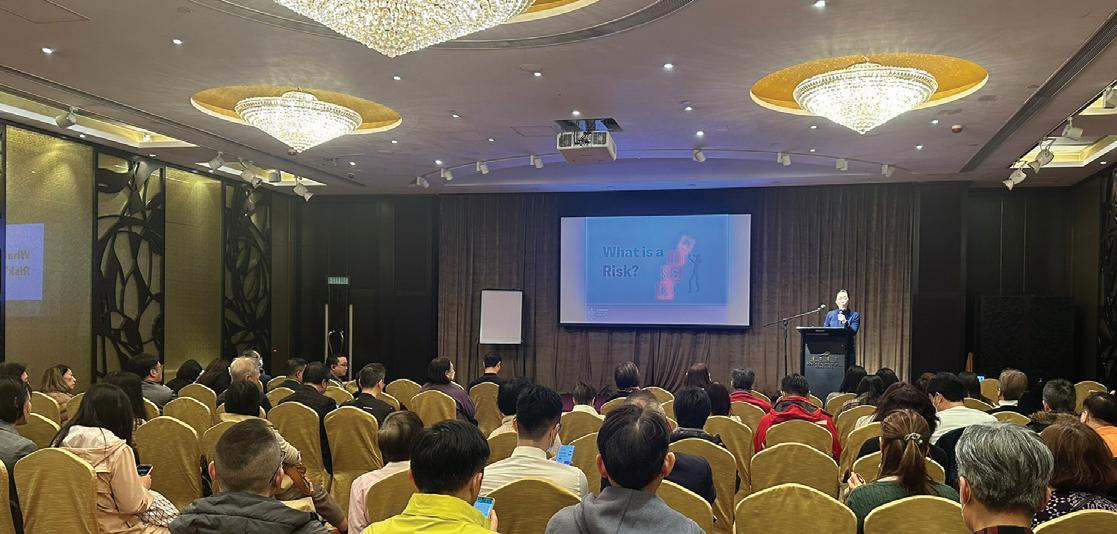
The CII Hong Kong held a range of learning events in March to support members’ professional qualifications and continuing professional development (CPD). These included comprehensive courses on insurance principles and practices hosted by a speaker from the UK, to provide learning on insurance law, insurance principles and contracts.
The courses also supported the ongoing learning of the Hong Kong Confederation of Insurance Brokers and the Professional Insurance Brokers Association, through topics and speakers relevant for their members, as well as providing CPD through webinars and seminars.
‘GO
SESSION
Following the overwhelmingly success of the ‘Go Ahead and Be your Best’ event held in January and hosted by the Honourable Chan Kin-por of the Legislative Council of Hong Kong, the event was held again in March.
Kin-por again hosted, sharing stories of his remarkable career journey and his thoughts on key topics from the insurance market.
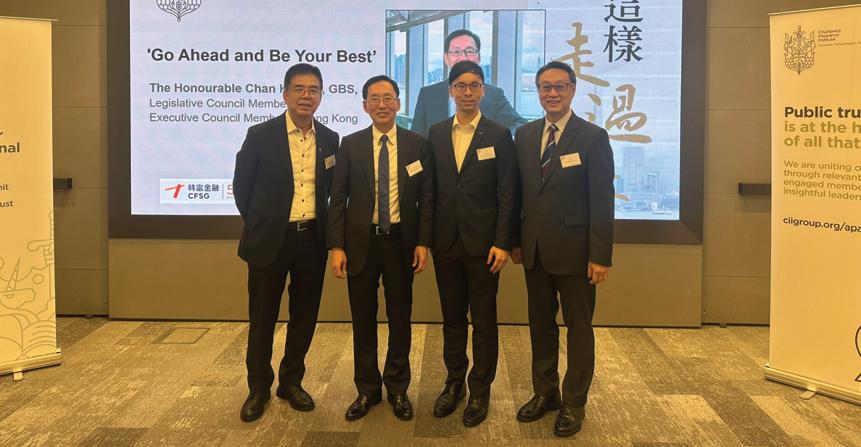
Gaenor Jones, regional director for the CII, recognised the Middle East region’s developments within the insurance sector during her closing speech at the 34th General Arab Insurance Federation (GAIF) conference.
Jones, who was recently awarded Woman Leader of the Year at the Middle East Insurance Industry Awards, said: “I don’t think there are many Arab countries that do not have insurance growth high on the agenda. We are seeing insurance playing a more pivotal role with regulators and governmental departments and these actions, as well an increase in upskilling, are putting the Middle East insurance sector on a global platform, and the region is receiving recognition for its development and success.”
The conference, which took place in Oman, held the largest gathering of insurers in the region and covered topics such as
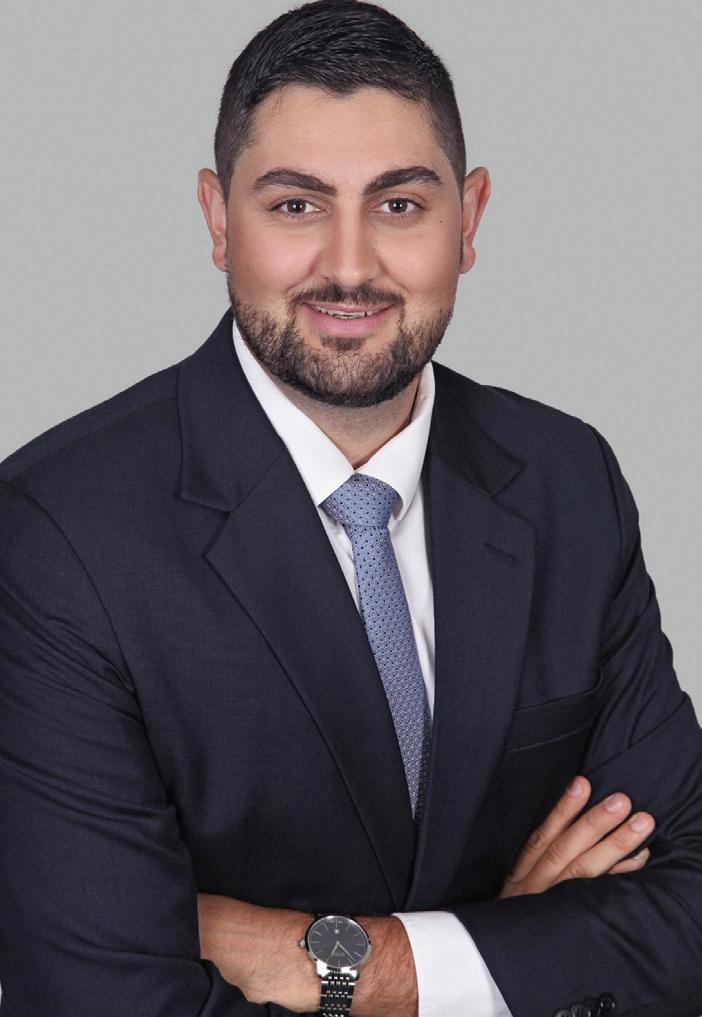

industry trends, emerging risks, technological advancements and evolving legislations. When asked about steps the CII has taken to support students within the region and engage with the market, Jones advised that the most popular CII qualifications are available in both English and Arabic, and study units have also been ‘internationalised’, replacing the UK focus with neutral terminology to cater to Middle Eastern students.
The CII Middle East office was set up in Dubai in 2018, and has since worked with and supported regulators, corporates and other entities throughout the region to upskill and boost technical expertise. There are currently more than 2,500 CII members based across the Middle East.
The CII team in Dubai has appointed Ian Mellows as corporate development manager. Mellows boasts an 18-year career in the insurance profession where he has held multifaceted roles including administration, operations, trading relationship management and sales. He will be working alongside CII regional director, Gaenor Jones, in a dedicated drive to advance the growth of the Middle East regional business.
Mellows’ responsibilities include fostering new relationships with stakeholders, regulators corporates, training providers, banks, and individuals, as well as maintaining existing key partnerships.
Following the appointment, Jones commented: “We are delighted to welcome Ian who brings with him a wealth of experience gained across many areas of the sector, here and in the UK from both the Insurance and Financial Planning disciplines. He will make a very positive contribution to our efforts across the region and in the days to come we look forward to introducing him to our partners, associates and members.”

8 MAY
FCA CLIENT MONEY RULES FOR GI → 12pm – 1pm Insurance Institute of Luton and Hertfordshire www.cii.co.uk/lutonhertfordshire
The Insurance Institute of Bristol Annual Dinner provided the celebratory backdrop for its annual prizegiving to its most meritorious members in 2023/2024.
With more than 200 guests in attendance, institute president, Amy Cooke, presented awards to those members who achieved exemplary marks in completing their CII and Personal Finance Society (PFS) qualifications.
Prizes for top achievement:
● Diploma in Insurance – Laura Biggs of DAS Legal Expenses.
● Diploma in Regulated Financial Planning – Christopher Ball of St James’s Place Partnership.
● Advanced Diploma in Insurance – Katie Furse of ARAG.

@SepsisUK Itwasaprivilegeto have been invited bythePresidentof theBirmingham @CIIGrouptospeak onbehalfofcharity beneficiaries @UKSepsisTrust lastnight.Quite thenight!


DIRECTORS AND OFFICERS’ LIABILITY IN A HARD MARKET → 10am – 11am
Insurance Institute of Shropshire & Mid-Wales www.cii.co.uk/shropshire 15 MAY



● Advance Diploma in Financial Planning – Michael Adair of Swan Wealth Management.
● Fellowship of the PFS – Alena Zavarin of Hugh James.
Cooke commented: “We were delighted to be able to recognise the success of
1pm
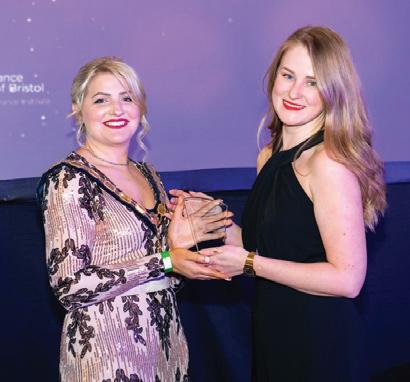
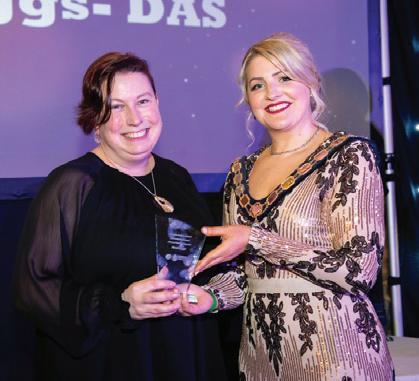
so many Bristol members. The local marketplace is vibrant and thriving, and we look forward to celebrating successes both now and in the future.”
→ For more information, visit: www.cii.co.uk/bristol
The Insurance Institute of Manchester’s famous Style in the City event returns for 2024, taking place on Friday 28 June 2024 at the city’s Midland Hotel.
With a 1990s nostalgia theme, this year’s event promises to take guests “back to the decade before social media and camera phones, with the most memorable fashion and music”. The organisers add: “So why not dive into the retro atmosphere? Show off your best Macarena moves or even throw some shapes like it’s a Friday night at The Hacienda!”
With a full afternoon plus afterparty at the Revolucion de Cuba bar, Style in the City 2024 promises to live up to its party reputation!
And it is all done for a good cause –this year the event is raising funds for its chosen charity Reuben’s Retreat (www. reubensretreat.org), which supports families who have suffered the loss of a child or have a child living with medical complexities.
→ For more information, visit: www.cii.co.uk/manchester

The Insurance Institute of Stoke on Trent has announced its inaugural President’s Leadership Mentoring Programme, aimed at a select number of its members working in the local insurance and financial services market.
The six-month programme has been initiated by the council to support local talent by exploring development opportunities and demonstrating that there are progressive, sustainable careers for ambitious individuals in Staffordshire.
This programme has been curated to enhance career development, develop practical tools and increase emotional intelligence in a supportive, practical, enjoyable learning environment.
The programme is led by coach and trainer, Katie May Beardmore and includes five half-day in-person sessions.
→ For more information, visit: www.cii.co.uk/stoke
The Insurance Institute of Leeds has launched its 2024 Building Champions Coaching and Evolving Leadership programmes, for members at various stages of their career pathway.
Led by local former rugby league legend Jamie Peacock MBE, the Building Champions coaching programme features bespoke sessions tailored to individual business and personal needs, examining behaviours that may hold back individual progress and exploring positive habits for lasting change. It is aimed at senior managers, directors and business owners.
The Evolving Leadership programme is aimed at member professionals who are at the start or in the middle of their own leadership development and who have a strong desire to develop personally, to help develop and enhance their leadership skills.
Run by Highridge HR Consultancy, the training sessions will be challenging, interactive and inspiring, designed to help delegates learn best practice in leadership and management, client care and solving problems.
→ For more information, visit: www.cii.co.uk/leeds
The Insurance Institute of Coventry achievers were welcomed to its inaugural exam presentation ceremony in March, to celebrate their successes.
Members who had achieved exam success during the past three years were joined by volunteers from the Coventry Institute council, led by president, Robert Boland, to enjoy an evening of celebration.
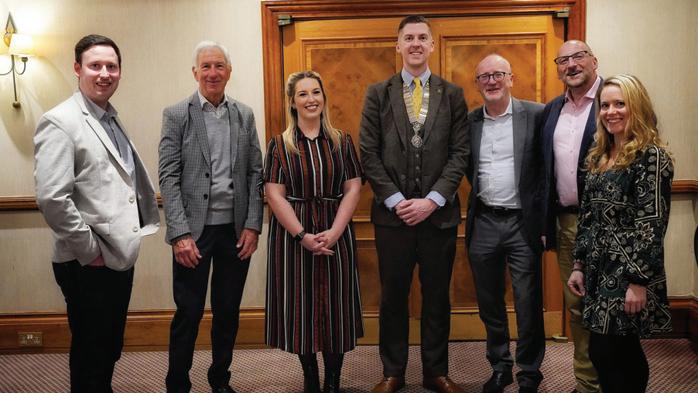
CII communications director, Chris Shadforth, was in attendance as CII representative and helped present certificates of achievement to members – including Coventry president Robert Boland himself.
Members who attended to receive recognition of their achievements were:
● Robert Boland – Advanced Diploma in Financial Planning.
● George Brandist – Diploma in Regulated Financial Planning.
● Emily Burrows – Diploma in Insurance.
● Milena Damjanovich – Certificate in Financial Services.
● Craig Fielder – Diploma in Insurance.
● Naomi Fielder – Diploma in Regulated Financial Planning.
● Linden Flint – Diploma in Insurance.
● Jason Million – Advanced Diploma in Financial Planning.
● Charlie Parsons – Diploma in Regulated Financial Planning.
● Charlotte Reynolds – Diploma in Regulated Financial Planning.
● Hannah Stanley – Diploma in Regulated Financial Planning.
● Victoria Sharman – Certificate in Financial Services.
● Sylvia Jane Warwood – Advanced Diploma in Financial Planning.
President, Boland, said: “Our inaugural awards evening was a fantastic event, enabling us to showcase and recognise our members’ achievements. I feel we need to promote and embrace our qualification framework to ensure we futureproof our industry. Achieving any qualification takes a lot of commitment and dedication and events like this are designed to allow our recipients to celebrate their achievements and be recognised in front of their friends, family and peers.”






As global marine markets face ever-changing threats, industries worldwide struggle with the significant impact on supply chains. Liz Booth reports
Global supply chains are a precious thing. Economist Impact reports that disruptions in supply chains can cost firms more than 40% of a year’s profit every decade and, with some 80% of global trade travelling by sea, it is no wonder that the marine markets and global supply chains are so interlinked.
In recent months, global supply chains have been stretched to breaking point by a combination of Houthi rebels, pirates, climate change and now by the catastrophic bridge collapse in Baltimore.
The global marine insurance market is waiting to assess the final fallout and global impact of the accident, in which the container vessel Dali crashed into Baltimore’s Francis Scott Key Bridge, which then collapsed into the Patapsco River, killing six people.
The Port of Baltimore is the largest in the US for specialised cargo (specifically for wheeled cargo, such as trucks and trailers) and bulk handling facilities.
It is estimated that about 800,000 vehicles passed through the port in 2023, moving a record 1.3 million tons of imported cargo.
As a result of the closure of the Port of Baltimore due to the collapse of the Francis Scott Key Bridge, there could
be $8bn (£6.4bn) of lost trade, warns Russell Group, a data and analytics company. Some $1.5bn (£1.2bn) worth of car exports, along with $377m (£300m) of coal exports, will be disrupted for the six weeks that follow, according to calculations by Russell’s ALPS Marine. Russell’s analysis covers the time period from 26 March to 7 May, in line with current estimates for how long the port may be out of commission for. This equates to $16m (£12.7m) a day in lost trade as the port remains out of a commission for a considerable amount of time.
Automakers that use the port, such as General Motors, Ford Motor, Toyota, Nissan and Mitsubishi, have said they are monitoring the situation. Many of these automakers have an estimated $552m (£437m) of lost trade during this period.
“The port plays a vital role in moving many items in and out of the US, including cars and coal,” says Suki Basi, managing director of Russell Group. “Furthermore, by being one of the largest ports for car trade in and out of the US, many global carmakers will be monitoring the situation in the coming days and weeks.
“In addition, with the port now out of action, shipping operators will
be diverting their ships to alternative ports on the east coast, which could create some delays at these ports.”
In terms of the global supply chain impact, Emily Stausbøll, market analyst at Xeneta – an ocean freight shipping rate benchmarking and intelligence platform – says: “It is likely other larger US east coast ports such as neighbouring New York/ New Jersey and Virginia can handle additional container imports if Baltimore is inaccessible, which may limit any impact on ocean freight shipping rates. However, there is only so much port capacity available and this will leave supply chains vulnerable to any further pressure.”
Events impacting global trade:
● Climate change: Panama Canal slowdown resulting in ships sailing round the Cape, adding time and cost.
● Pirates: resurgent in the Gulf of Aden, adding to costs as owners forced to add greater security.
● Houthi rebels: attacking shipping in the Red Sea, adding cost and time to deliveries now transiting the Cape.
According to S&P Market Intelligence, the value of the bridge itself could be about $1.2bn (£1bn). It is not yet known if the insured limit on the property placement will fully cover replacement, says Loretta Worters, a spokesperson for the Insurance Information Institutes.
Insurance Insider reports that Chubb is the lead insurer of the bridge itself, but any claims are likely to be subrogated to the shipowner’s insurance. And it is understood Aon had brokered the risk as part of the bridges and tunnels property placement for the State of Maryland.
The incident will impact the International Group of P&I Associations the hardest, according to Worters, who says the group has significant reinsurance coverage, led by Axa XL.
Bridges are typically covered under the inland marine insurance market, Worters says. Liability insurance also protects bridge owners from legal claims arising from accidents and injuries.
Business interruption insurance could also be a factor as it serves to offset loss of revenue or costs incurred during repair or reconstruction of the bridge.
Moody’s Ratings analyst Brandan Holmes believes: “The Key Bridge collapse in the US will likely lead to substantial insurance claims against the vessel’s insurers related to the ship and its cargo, but more significantly the destruction of the bridge and disruptions to the port.
“The majority of claims will fall to global reinsurers, as approximately 80 different reinsurers provide about $3bn (£2.4bn) in cover to the ship’s insurers, Britannia P&I Club and the International Group (IG) of P&I Clubs. While the total claim is expected to be high, it is unlikely to be significant for individual reinsurers since it will be spread across so many.”
Meanwhile, Allianz recently published shipping collision and
contact incident statistics from the Allianz Commercial Safety and Shipping Review, which show there have been close to 2,000 reported incidents of vessels colliding with port infrastructure, such as harbour walls, in the past decade around the world (1,980 between 2013 and 2022), making it the fourth most frequent type of shipping incident during this period (about 7%), out of more than 27,000 in total. Machinery damage/ failure (10,753), collision involving vessels (3,098) and groundings (2,936) are the other top causes of incidents during the period.
But the Baltimore incident is just the latest in a long line of other events impacting the flow of global trade. Since November 2023, there have been more than 60 attacks on shipping by Houthi rebels. They announced that they would target any shipping with Israeli, US or UK links but in fact the attacks have been much more widespread.
Reports suggest the attacks have caused a 40% drop in Red Sea cargo and a surge in shipping taking the three-week-longer route via the southern tip of Africa and the Indian Ocean. Added to that, the International Monetary Fund says traffic through the Suez Canal was 50% down in the first two months of 2024.
In February, it was reported by the Russell Group that a quarter of all British tea imports is at risk from the current Red Sea disruption. Its research found that £157m worth of tea imports from nations including India and Kenya are at risk of being delayed due to the crisis in the Red Sea. This is roughly one quarter of all British tea imports, which in 2023 equated to £683m, according to ALPS Marine.
Many of Britain’s supermarkets have warned that the length of the current crisis in the Red Sea will determine the extent of the shortages on their supermarket shelves. However, the British Retail Consortium (BRC) says it has seen “temporary disruption” to some black-tea lines.
This follows recent announcements
£6.4bn
The closure of the Port of Baltimore due to the collapse of the Francis Scott Key Bridge, could result in £6.4bn loss of trade
Source: Russell Group
by many clothing brands, including Next and Primark, which have warned of the potential disruption to their supplies by the crisis.
And its not set to improve anytime soon, with Reuters reporting that Somali pirates have begun to take advantage of the situation and since November there have been more than 20 attempted hijackings, which have driven up prices for armed security guards and insurance coverage as well as raising the spectre of possible ransom payments, according to industry representatives.
Two Somali gang members were open in telling Reuters that they were taking advantage of the distraction provided by Houthi strikes several hundred nautical miles to the north to recommence piracy after lying dormant for nearly a decade.
Finally, if this was not all enough to disrupt trade, a drought in the Panama Canal meant ship transits were limited to 24 per day until April, when the authorities were set to re-evaluate at the start of the rainy season. The number of ship passages was 30% lower than usual by the end of 2023.
Other reports explains the importance of that figure – the canal manages nearly 3% of overall global maritime trade volumes, with a 46% share in containers originating from northeast Asia and headed to the US east coast. Nearly 40% of all US container traffic uses the canal annually, affecting the movement of roughly $270bn (£216bn) in cargo.
Supply chain disruptions at on the oceans, it seems, are set to continue for the foreseeable future. ●
Liz Booth is contributing editor of The Journal



In both the UK and the US, fear of flooding is becoming significantly more widespread and an increasing number of customers are turning to their insurers for help in mitigating the rising risks.

In December last year, US mortgage financing company Fannie Mae warned after price hikes in flood insurance across the US that “these increases could have tangible impacts on consumers”.






It found that consumer concerns regarding flood insurance premium increases went up significantly during 2022, with 43% stating they were extremely or very concerned. This was up from 31% in 2020 and became even greater among respondents living in high-risk areas.

“significant”. Certain factors, like the rising severity and frequency of natural disasters, are even leading some insurers to stop writing new policies or pull out of certain states altogether.


Many respondents had also become aware of increases to their homeowners’ insurance premiums, the research found, with about 20% reporting their premium increase to be




Flood insurance has taken on new significance in the face of wetter winters. Liz Booth examines the impact of the Consumer Duty on how flood victims are treated by their insurers















The survey revealed that respondents are also increasingly worried about possible reductions in home value if their residence were to be designated as located within a highrisk flood zone (24%). This was most pronounced among respondents with property already located in high-risk areas (29%). Furthermore, the overall concern about mandatory insurance requirements if their property were to be listed as high-risk for flooding has increased since 2020 (26% in 2022 versus 20% in 2020).



What does this have to do with the UK? Well, it seems concerns around flood insurance across Britain are equally considerable.

With Aviva reporting back in 2021 that one in five properties was at risk from flooding and, given the recordbreaking wet winter just passed, it provides some scale of the problem. In fact, insurers paid out some £352m in claims after the October and November storms alone.


Added to that is the reality that the cost of home insurance increased 5






some 40% in 2023, with the average house and contents insurance bill currently standing at about £350 a year. Insurance might still appear value for money after a flooding event, however, when faced with months of repair work and lots of precious items lost. But how does the insurance industry prove its value?
Dr Matthew Connell, CII director of public and policy affairs, believes the new Consumer Duty introduced last year will play a part.
“With the Consumer Duty, general levels of customer service have come within the scope of regulation for the first time,” he says. “The ‘customer support’ outcome means that unreasonable delays over payment of claims are in breach of regulatory standards and the UK Financial Conduct Authority (FCA) expects insurers to be monitoring factors like call abandonment rates to ensure that claims lines are adequately staffed. Clearly, building processes that can withstand a surge in demand is not only a brand issue, but a compliance issue as well.”
He says the CII’s Trust Index shows that among small and medium-sized enterprises (SMEs) and consumers, perceptions have improved around claims but expectations are also very high (see chart).
The Association of British Insurers (ABI) stresses: “It is an insurer’s first priority when a customer is flooded to help them get their lives back on track as quickly and safely as possible
by providing emergency payments, alternative accommodation and carrying out appropriate repair work.”
The ABI explains that insurers are well used to dealing with flood claims, often using a loss adjuster to help assess the damage and repairs required. But communication is vital in maintaining the confidence of the consumer.

This is particularly true with vulnerable customers, the ABI says.
“Insurers must act in a customer’s best interests,” it adds. The ABI has produced guidance for insurers on what this might look like.

The purpose of this best practice guidance is not to define who a vulnerable customer is, as this

will depend on the particular circumstances of each individual customer. Instead, a combination of factors may be present for these principles to apply, including:
● The claim involves a vulnerable customer.
● Severe damage to the customer’s property.
● Complex repair works are required.
● The value of the claim is substantial.
● The customer is residing in alternative accommodation.
“In most instances, cash settlements will be offered to customers at the reinstatement phase, after the insurer has carried out decontaminating, stabilising and drying works,” continues the ABI. “This is because, while building works will be more familiar to customers, drying and decontamination works are carried out by specialists engaged by insurers. For vulnerable customers, an insurer should consider whether offering a cash settlement for the entire project/claim is appropriate in light of the particular circumstances of the claim, including assessing whether a suitably experienced supplier has been engaged to undertake drying works and the best interests of the customer.”
Looking after the consumer is also top of the list for insurer Axa, where a spokesperson from the firm notes: “We are committed to delivering the best possible customer outcomes and our ‘customer first’ value is at


the heart of business operations, so we welcomed the FCA’s Consumer Duty, which places further emphasis on protection and a fairer consumerfocused playing field. We have also worked with our broker partners and suppliers to ensure these requirements are embedded and our customers receive clear information on the policies they purchase from us.
“We believe we have an effective claims handling process that provides the best service for our customers. Our customer satisfaction score reflects this, with a Feefo rating of 4.4%. However, we continuously look at ways to improve the service we provide.”
Despite all these good intentions across the industry, however, it seems complaints still emerge. The Financial Ombudsman Service (FOS) says complaints include:
● Disagreement as to whether a flood took place.
● Disagreement as to whether a flood caused the damage being claimed for.
● Repairs to a property not being good enough, or not restoring the property to its original state.
ABI members agree to the following best practice principles:
1. Insurers will discuss with their customer how to best communicate with them.
2. Insurers will satisfy themselves that the cash settlement amount offered is satisfactory in light of the estimated costs to reinstate the property.
3. Insurers will clearly inform customers of the potential implications of accepting a cash settlement.
4. Insurers will undertake necessary checks to assess the capability of a customer to manage the reinstatement process.
5. Insurers will clearly communicate their role after the cash settlement amount is paid to the customer.
● The requested repairs being preventative and not covered by the policy.
● A dispute about whether the repairs to a property will be ‘lasting and effective’.
● Flood damage being discovered long after flooding, usually during renovations.
● Payments for alternate accommodation being stopped, even though the consumer can't move back into the property.
● The consumer not being able to live in the property although their claim for alternative accommodation has been rejected.
● The consumer not being happy with the alternative accommodation provided.
The FOS has plenty of advice for insurers when handling a complaint like this.
“When you receive a complaint involving flooding, you should reply to your customer within eight weeks,” it suggests.
“We only look at a complaint that you have had a chance to look at it first, so that you have the chance to put things right. If a consumer complains and you don't respond to them within the relevant time limits or they are not happy with your decision, they can bring their complaint to us. We will check it is something we can deal with and if it is, we’ll investigate.
“We will expect you to demonstrate that you have investigated the complaint thoroughly and that you have reflected carefully on the circumstances.”
It warns that to reach a decision about what’s fair and reasonable, as with every case, it will consider:
● The relevant law and regulations.
● Any regulator’s rules and guidance that applied at the time.
● Any industry codes of conduct in force at the time.
● What it considers was good industry practice at the time.
While flood insurance claims are inevitably increasing, it seems that with Consumer Duty principles and strong complaints procedures in place, insurers are well placed to meet the rising tide. ●
Liz Booth is contributing editor of The Journal
With generative AI already in widespread use across the insurance sector, Fiona Nicolson examines the benefits, risks and further use cases
Artificial intelligence (AI) is no longer a future concept for insurance – its applications are well underway, as the industry has seen and acted on its potential.
According to the British Insurance Brokers’ Association’s 2024 manifesto, AI is already being used by insurers and brokers in a wide variety of ways, such as assisting with remote home inspection for quotes and claims, fraud detection, client verification, compliance checks, chatbots in customer support and underwriting.
The advantages of AI, such as cost reduction, could be significant. Boston Consulting Group recently said generative AI has the potential to reduce claims payouts by 3-4% and to provide a 20-30% reduction in loss-adjustment expenses. A report by Data Bridge Market Research on AI trends in the insurance market (2023-2030) says AI can lower claims-processing costs by 50-65% and processing time by 50-90%, while also enhancing the customer service experience.
Industry enthusiasm for AI is reflected in EY’s 2024 global insurance outlook, which found that 58% of chief executives see it as a ‘force for good’ and 52% are planning ‘significant investments’ in AI within the year.
Use of AI is now evolving further within the insurance sector.
Avin Talabani, programme manager at Clear Insurance Management, observes: “AI was perceived as a buzzword but the capability has matured significantly.”
Paul Hollands, chief data and analytics officer at Axa UK and Ireland, explains how the insurer is using new technology: “We have had machine-learning models in place for a while, helping us more effectively identify risk in our pricing models and enabling us
to make better decisions through our claims processes. We are now exploring where technologies such as generative AI can help us accelerate time-intensive manual processes and improve accuracy and consistency.
“Our retail team is currently testing an AI assistant that mimics humans, to create sophisticated, conversational and relevant responses to prompts. We are also exploring the use of AI-led co-pilots that improve the speed at which our engineers and analysts can write code.”
He adds: “In our commercial business, we were able to review more than 70,000 multi-page documents for mentions of RAAC (reinforced autoclaved aerated concrete). This job would have taken at least 12 months to complete manually but we were able to check the documents to identify buildings at risk in just a few hours.”
Home insurers are also recognising AI’s potential for efficiency and output. “With generative AI, I think we are seeing the start of a massive productivity boost,” says Dan Huddart, chief technology officer at Homeprotect, part of the Avantia Group. “I don’t look at AI and think it will replace a particular role any time soon but it will vastly increase the quality and quantity of what we can do in a day.”
most insurance businesses will face in the coming months and years is the commercial pressure to roll out AI and keep up with what it is perceived that their peers in the sector are doing, before deciding whether they should or whether there is a real need to use it.
“Legal, risk and compliance teams are going to have to ensure appropriate processes, policies, governance and education are in place to ensure AI is rolled out safely, lawfully and ethically before it becomes too integrated and we start to see the risks emerging,” says Halford.
Rory Yates, chief strategy officer at insurance platform EIS, highlights the importance of human involvement in the technology: “AI is a double-edged sword – its ability to detect fraud is matched by its ability to commit it. We must keep a human ‘in the loop’ at all times to avoid problems.”
AI IS A DOUBLE-EDGED SWORD – ITS ABILITY TO DETECT FRAUD IS MATCHED BY ITS ABILITY TO COMMIT IT. WE MUST KEEP A HUMAN ‘IN THE LOOP’ AT ALL TIMES TO AVOID PROBLEMS
Mat Paixao, director at Davies, observes another area where AI has become useful: “An up-and-coming area where insurers are increasingly adopting AI is the complaints function. We are seeing a number of insurers use it to help with drafting of letters, while still maintaining a human eye on quality.”
The risks, however, could also be considerable. Charlotte Halford, partner at solicitors DAC Beachcroft, observes: “The key challenge that
Hollands also emphasises the importance of combining the ability of people with that of AI: “Safe and responsible use of AI is key, particularly if it involves the use of our customers’ data. We believe it is important to take a cautious approach and look at using data and AI platforms in a way that supplements the expertise of our agents and the documentation available.”
Commenting on the next stages, Patrick Hayward, senior consultant and claims lead at Altus Consulting, points to the contribution that as yet only humans can make: “In reality, there are few business functions that AI will not touch in the longer term.
“However, while we expect the role of AI to expand across insurers’ functional capabilities, there will continue to be a need for human interaction and empathy.” ●
FionaNicolson is a freelance journalist

With climate change resulting in ever more unpredictable weather patterns, Tim Evershed examines the growing threat from so-called secondary perils
Global insured losses from natural catastrophes exceeded $100bn (£79bn) during 2023, according to data from catastrophe modellers, brokers and reinsurers. This was the fourth year in succession that losses breached the $100bn mark, making such numbers the norm rather than the exception.
The data also showed a significant protection gap, with total economic losses surpassing $350bn (£277bn).


However, a quiet hurricane season saw ‘secondary’ perils in focus as the driver of losses during 2023. A secondary peril is a natural hazard that on average produces small to midsize damages compared with ‘primary’ perils such as earthquakes or hurricanes. Common examples include severe convective storms (SCS), wildfires, floods and droughts.
According to Willis Towers Watson (WTW), US insurers saw the costliest SCS year on record, with total claims exceeding $50bn (£40bn).
The average annual losses in the US from SCS – which are difficult to predict from a meteorological forecasting standpoint and unpredictable due to climate variability – are higher than the average annual losses from hurricanes, adds Moody’s RMS.
In fact, secondary perils have accounted for more than 50% of global insured natural catastrophe losses on average during the past six years. Secondary perils are now a focal point for risk managers following a year dominated by these events.


“In a world increasingly shaped by ageing infrastructure, climate change and urban growth into risk-prone areas, we are now facing disasters that were either not anticipated or deemed unlikely just a few years ago,” says Cameron Rye, head of modelling research and innovation, WTW Research Network.
“Beyond economic damages, 2023 highlighted the need for a proactive approach to risk identification, mitigation and adaptation.”
As losses from secondary perils have risen in recent years, so have calls from insurers for them to be rebadged as ‘earnings’ perils. Proponents say this would acknowledge that what might be secondary in terms of individual event losses can still have a primary effect on their profitability in aggregate.






Not only did 2023 see claims exceeding $50bn from SCSs, Hawaii witnessed its deadliest wildfire in recent history, northern Italy faced an unprecedented hailstorm and the Panama Canal experienced its worst drought since it opened in 1914, leading to major global shipping disruptions. In addition, flooding caused destruction globally, with notable events in Slovenia, New York City, Hong Kong and Beijing.

According to ratings agency Moody’s, 2023’s SCS will reinforce the need to seek further rate increases and take other underwriting actions, such as tightening terms and conditions around weather-related perils.
Sarah Hibler, associate managing director, financial institutions at Moody’s, says: “We expect premium growth
to be slower in 2024 than in recent years and coverage level increases are also likely to slow. Some companies have opted to exit states where they are not able to meet targeted returns.
CLIMATE RISK IS A CERTAINTY, NOT A PROBABILITY



“In response to growing non-peak perils, insurers are incorporating more recent experience into their modelling and pricing. Many homeowners’ insurers have continued to increase their catastrophe budgets.
“Insurers are also adopting or updating SCS models, which are relatively new compared to hurricane and earthquake models. In time, we expect further progress in modelling these complex events,” says Hibler.
In addition, 2023 was a year of climate records. Extremely high temperature anomalies recorded in many parts of the globe resulted in it being reported as the warmest year on record. The scale of the warming was evident as seven months of the year broke records for their highest temperatures. The oceans also saw exceptional warmth, with global sea-surface temperatures at record monthly highs from April through December.


According to Aon, the behaviour of many natural perils continued to be affected not only by the warming trend, but also by the El Niño conditions during the year. The broker says the many significant events highlighted the need for better disaster preparedness and planning to reduce risk, protect lives and promote resilience.
“Climate risk is a certainty, not a probability,” says Greg Case, CEO of Aon. “Throughout 2023, wildfires across Europe and North America, flooding in Asia and record-breaking heatwaves in the US and Latin America demonstrated that severe weather and climate-related risks now pose an existential threat to the way we live and work.”


According to Aon, collaboration is essential to develop effective solutions. Because climate risk is such a complex problem, no single industry or discipline can solve it alone. Businesses, governments and the scientific community are realising that they need to bring all of their capabilities together to address climate risk.
Case says: “To tackle climate risk and bring about a true net-zero economy, an estimated $150trn (£118trn) in capital will need to be deployed over the next 30 years. We have observed that capital is hesitant to go where it is not protected or where returns are less certain. The insurance industry can play a pivotal role in unlocking and speeding up the flow of capital into green investments and volatility management through innovative risk transfer programmes.”
Tim Evershed is a freelance journalist



Luke Holloway speaks to Enas Asiri and Suresh Nair, two new CII vice presidents tasked with augmenting the Institute’s work across the Middle East and beyond

At the turn of the year, the CII welcomed two new vice presidents to support the international work of the organisation and strengthen the member experience of those based outside the UK.
Enas Asiri and Suresh Nair are both longstanding members of the CII
and bring with them vast and varied experience from insurance markets across the Middle East.
“I firmly believe that being a member of the CII has not only helped shape me professionally and accelerated my career advancement, but also helped me to demonstrate how committed I am to the insurance profession,” Asiri tells us.
“When I learned about the opportunity to serve as CII vice

president for international markets, I really wanted to give back to the Institute that played such an integral part in my career and helped me gain the recognition and trust of my employees, peers and business partners,” she says.
Asiri – a Chartered insurer and
Fellow of the CII – has 16 years’ experience in insurance and reinsurance, spending her career working across the life and health sector before joining Bahrain National Life Assurance six years ago, where she is now CEO. She also serves as a board member for a number of national institutions in Bahrain, including the Bahrain Institute of Banking and Finance, Bahrain Insurance Association, and Health360 Ancillary Services, as well as being a committee member at the Bahrain Chamber of Commerce and Industry.
“Having gone through the complete journey with the CII as a member based in the Middle East, I can definitely relate to the experience of many other international members,” says Asiri. “It will be valuable not only for me to convey the international community’s feedback to the CII in a more effective way, but to make relevant and practical suggestions to enhance the member experience and maximise the value members can gain from the CII’s offerings. I really look forward to contributing in a positive way.”
Nair, meanwhile, has been in the insurance profession for more than 30 years working as both an underwriter and broker across three countries –India, Oman and the United Arab Emirates (UAE), where he is currently executive director at Gargash Insurance Services.
“My association with the CII goes back almost 30 years,” Nair tells us.
“By the time I reached the Middle East in 1992, I had already obtained insurance qualifications from the Insurance Institute of India.
I then quickly learned that studying through the CII would be a huge asset for further career progression. Even though the workload was considerable
alongside my new role in a new country, I knew that I needed to muster up the passion to complete the ACII as soon as I could,” says Nair.
“Achieving my ACII and then becoming a Fellow of the CII has been incredibly valuable to my career and it has been a long and very fruitful involvement with the CII ever since. Our firm, Gargash Insurance, has been awarded CII corporate Chartered status, so my involvement with the CII continues and I cherish every bit of it,” he says.
The CII has members across 150 countries and, as well as strengthening the member experience of those throughout the Middle East, the new vice presidents will work with the CII to develop products and services to build public trust in the insurance and financial planning professions in markets across the world.
In the Middle East, that work will continue from an already strong place, Nair believes. “The CII has been recognised in the region for a very long time,” he says. “Even by the 1990s, the CII had established a substantial amount of acceptance, trust and goodwill, and has continued to build on that to the present day.
“In the local markets, the CII is recognised as best in class for insurance learning, education and standards, and it is generally regarded by insurers, regulators and the public as the gold standard, so to speak. There is a CII Middle East office in the UAE which has done some excellent work in recent years.”
Asiri agrees: “To begin with, it is very important to recognise that in many markets, the CII is viewed as a powerful brand and CII qualifications are seen as highly attractive. That said, there are certain things that can be done to enhance membership overall.
“Increasing local market activity such as networking events, continuing professional development access and improved communication in general would undoubtedly enrich the value 5


of CII membership,” says Asiri.
Becoming more relevant to various markets and the professionals within them is also an opportunity, she tells us. “Different markets have different regulatory practices, different languages, and different topics that are more relevant than others,” she says.
In addition to being global ambassadors for international members of the CII, the pair will share chairing the International Affiliated Institute Forum, which acts as a mechanism for the CII to consult its global affiliated institute network.
“Our main focus will be supporting the CII board and management, be it through specific projects or by raising the profile of the Institute internationally,” says Nair. “But importantly, we will also engage with the CII’s International Affiliated Institutes in areas that benefit both the CII and its 32 affiliated institutes, which are spread across the world.
“The forum promotes collaboration and partnerships with the CII, while fostering exchange of best practice for development across
the wider industry. The relationship has to be synergetic, so we will be continuously identifying areas of mutual benefit and ensure that it aligns with the vision and strategic plan of all entities involved,” says Nair.
And there is much to discuss, as Asiri points to a positive time for many Middle Eastern markets which are experiencing strong economic growth.
“We are seeing significant investment across both private and public sectors, as well as a reasonable population and insurance market scale. This is resulting in the growth of local and regional insurance and reinsurance companies across the Middle East,” says Asiri.
“At the same time, there are significant regulatory changes to improve the quality of the insurance sector in general across technical skills, sales and customer service, as well as practices in the space of climate change, cybersecurity and artificial intelligence. In a number of Middle Eastern markets, regulators have either introduced or will soon introduce recognised insurance qualifications on a mandatory basis for named functions or named positions within insurance
companies. All of this creates a lot of opportunity for various stakeholders – the CII being one of them.”
“The CII holds a very unique position,” adds Nair. “Because of the esteem and trust it is held in by its members, this trust also extends to corporates, regulators and the public. In terms of learning, qualifications and professional standards, it has a reputation of excellence, so stakeholders expect the CII to be a thought leader in the insurance sector. As long as the CII can maintain this cutting edge, it should be in a position of consultation with its members, regulators and industry leaders to help shape the future.”
Both vice presidents agree that there are challenges facing insurers across the world and that disruptive changes both in and outside of the industry can be expected. But they also agree there are incredible opportunities for the insurance profession to continue to grow internationally and be a vital part of the global economy.
“Yes, we are facing several challenges, including the need to keep up with changing technology, managing innovation, attracting and retaining top talent, and adapting to changing customer expectations,” says Asiri. “My hope for the future of the profession is to be able to manage the several key disruptors ahead of us through adjusting our operating models and directing our focus on mastering technology-driven changes, while investing in our human capital to lead those strategies accordingly to stay ahead of the curve and achieve the success that we all look forward to.”
Nair concludes: “It is up to the insurance profession to adapt quickly, be relevant and ensure that trust is maintained with the public. I am very hopeful and confident that the insurance profession will continue to thrive and I am sure the CII will play an important role.” ●
Luke Holloway is editor of The Journal Suresh Nair


















Dr Matthew Connell highlights the latest regulatory developments impacting insurers
TFour key areas of activity are:
he UK Financial Conduct Authority (FCA) published its business plan in March.
● Protecting consumers: The Consumer Duty was predictably at the heart of the FCA’s plans in this area. For insurance, one area that the FCA promised to focus on was the fair payment of claims.
● Ensuring market integrity: The FCA promised “to lead the debate on how the right form of regulation can support growth for UK markets”. The FCA said it “will continue to invest in our data and technology to support rigorous market oversight”.
● Promoting effective competition: In particular, the FCA wants “to look to market reforms that bring the benefits of innovation and digitalisation”.


● Our secondary international competitiveness and growth objective: The FCA promised to “facilitate medium- to longterm growth and competitiveness in a way that can secure better outcomes for all consumers, including through greater variety, price and quality of products and services”.
Finally, the FCA promised to “continue to make it quicker and easier for firms and people to apply for authorisation”, adding: “We will strengthen our data collection processes to reduce the burden on businesses.”



ApublishedareviewattheendofMarchwhichraised
The FCA published a review at the end of March which raised concerns about the way some insurers treat claims for writtenoff or stolen vehicles. It promised to engage directly with those that have issues that need to be addressed.
Areas of good practice identified by the FCA include:
● All the firms reviewed used trade valuation guides used by the Financial Ombudsman Service (FOS).
● Some firms offered, on average, settlement values closely aligned to retail guide prices.
● None of the firms reviewed used incentives that would encourage claims handling staff to depress vehicle valuations.
● Most of the firms clearly explained their settlement offers to customers.
● Most firms gave customers a good opportunity to provide relevant information about their car’s valuation.
● Most firms gave customers the opportunity to substitute the vehicle on their policy for the remaining term after a claim.
Aspects that gave the FCA cause for concern were:
● Some firms reported average settlement values that were lower than the available guide prices. Some did not monitor the average deviation between their valuations and trade guide prices, while some did not collect basic data on total loss claims.
● Some firms did not have sufficient oversight arrangements over third-party providers.

● Most of the firms made deductions based on the preaccident condition of the vehicle, which the FCA considered may be unfair in some cases, such as sizeable deductions for vehicles that were previously been classified as a total loss.
● Firms would sometimes provide low initial settlement offers, expecting to increase the offer if the customer complained.
● Some firms did not properly assess the effectiveness of a valuation methodology, either initially or on an ongoing basis.
● A small number of firms communicated in a way that may have put customers off complaining to the FOS.
● Some firms insisted on deducting outstanding monthly instalments from the settlement payment. ●

As the interest rates charged on premium finance come under the microscope, Dr Matthew Connell examines the notion of ‘fair value’
Western culture has always had an ambivalent attitude to charging interest, going as far back as the ancient Greeks. Throughout the Middle Ages, England had laws against usuary (the practice of lending money at unreasonably high rates of interest), but they were ignored so frequently that in 1571 an Act of Parliament allowed loans of up to 10% to be tolerated without prosecution.
This ambivalence continues to the present day. One example is the UK Financial Conduct Authority’s (FCA) rules on ‘premium finance’ – where annual premiums for insurance products like motor and home insurance are spread out in monthly payments, but where the overall cost is higher than if the premium was paid upfront.
The FCA’s rules, updated in 2021, say that insurance firms are failing to give good value “where they increase the price of insurance products because the customer is purchasing the policy using retail

premium finance, unless the firm has an objective and reasonable basis for making the change”.
The consumer group, Fair by Design has put the concept of ‘fair and reasonable’ under the microscope, saying: “People in poverty… pay more for their insurance cover because they can’t afford to pay for it all in one go. Additional charges for paying for car insurance monthly instead of annually could mean an extra £160.”
The FCA responded to this in its guidance on the Consumer Duty, saying in January this year: “Firms offering GI products with premium finance should also consider whether the level of interest charges for customers who can only afford to pay their insurance premiums monthly, will meet the requirements of the Duty.”
It went on to say: “We expect the price charged for premium finance to be proportionate with the cost of providing the service. As there is very limited credit risk, we would expect to see this reflected in the APR charged to customers.”
This led to speculation about the commercial impact this would have
on some well-known insurance brands, though the investment analysts at Morningstar pointed out that for some high-profile brands, premium finance rates were “much lower” than the “double-digit… rates” discussed by some media reports, and that one set of premium finance rates were “much lower than the current base rate of the Bank of England”.
The debate highlights issues around ‘fair value’. In this case, fair value appears to be an amount that is related to the cost of supplying a service, and that is not so high that it creates crosssubsidies between different groups of customers.
However, the FCA has also said: “Our intention is not to set prices and our rules do not have this effect. It also does not mean that firms are expected only to offer products and services at a low price. Products or services that cost more for customers may well provide value if that reflects their quality and benefits.”
This leaves some important questions – are all cross-subsidies a breach of fair value? If so, in a high inflation, high interest rate environment, is allowing
interest-free monthly payments poor value if it creates a cross-subsidy between consumers who pay in a lump sum against those who pay in instalments? For example, would it be fair for a less financially sophisticated customer who was not aware of the effects of inflation to lose out to a more wealthy and financially savvy customer who took advantage of the interest-free finance?
Digging a little deeper, it is also unclear how firms should assess the ‘benefits’ of a product. If a premium finance product that is charging the same as the Bank of England base rate is withdrawn and customers instead rely on a credit card or an overdraft to fund a lump sum annual premium, has

the customer benefited? What kind of spread between credit card debt and implied premium finance rates would be needed to reflect the “very limited credit risk” that the FCA views for premium finance?
Given all this ambivalence and ambiguity, it is unlikely that the FCA is going to do what the Parliament of 1571 did and put a numerical upper limit on a reasonable rate of interest. Instead, professionals faced with a responsibility to act fairly may wish to fall back on four questions in the CII Code of Ethics:
● Is this in the best interests of my client or my bonus?
● Do I say, ‘show me where it says I cant’ or do I say ‘is this ethical’?
● Are employees rewarded in ways that encourage them to put their client's best interests first?
● If the client is vulnerable, what extra steps can I take to make sure I act in my clients best interest?
If the debate on premium finance shows us one thing, it is that any concept of fairness has to be underpinned by strong ethical disciplines – something that has been true for more than 2,000 years and will continue to be true in the future. ●
Have you ever felt stuck, knowing that you want to grow, but struggling to identify how? Perhaps you have had a development conversation that left you feeling uninspired? As a manager, have you struggled to define development goals for your team?
If so, you are not alone. These are common challenges faced by professionals at all levels. This article explores, through the testimonials of three practitioners at different stages of their careers, how the CII’s Professional Map can be a powerful tool to navigate through these obstacles.
The Professional Map is a competency framework and career development tool that outlines the knowledge and behaviours required to succeed as an insurance professional, including:
● Technical expertise – the rolespecific knowledge and skills crucial for excelling in your job.
● Behaviours – the actions and attitudes that shape decisionmaking and work relationships.
● Enablers – skills that focus on cultivating awareness and understanding of aspects within the work environment that facilitate professional practice, such as regulations and compliance, and use of technology. Users can access a self-assessment tool to assess capability against the
Professional Map, empowering both individuals and their managers to set clear goals, prepare appraisals and interviews, manage teams effectively and ultimately enhance performance. Let’s hear some examples...




As a claims manager, I have completed the CII Professional Map evaluation process for myself and used this as a 360-degree feedback tool for my team. The tool lays out a clear roadmap and provides a structured approach to both personal development and professional advancement.
The Professional Map offers a comprehensive framework for self-reflection. It goes beyond simply listing skills by providing specific criteria for technical expertise, behaviours and enablers. Interestingly, the behaviour circles around inclusivity and diversity, which is designed to promote collaboration and diversity of thoughts.
The CII’s Vanessa Riboloni provides some tips on how to navigate your career development with the Professional Map
The Professional Map provides clarity – you receive clear descriptions of the ‘what’ and ‘how’ that is expected at different career stages. Additionally, the map outlines industry-wide competency standards across various roles, ensuring consistency and setting a benchmark for excellence.
The process is user-friendly and by understanding the expected standards and transferable skills, you can create a personalised plan to strengthen specific areas and present this in a clear way. One self-assessment that I liked was impactful communication competencies, which deals with confidence and negotiations.
Collectively, behaviours, enablers and technical expertise make up the standard for what it means to be a well-rounded professional in the insurance profession. Each band holds 11 competencies, made up of seven behaviours, three enablers, and the relevant area of technical expertise.
This is a focused and articulated way to prepare for performance reviews, self-development, or development of others. It structures the conversation and helps individuals to pinpoint strengths and empowers them with ideas on self-development and continuous improvement. I’m looking forward to reviewing the objectives to assess the progress made.




The CII’s Professional Map and self-assessment tool have been instrumental in helping me to clarify my career goals, discover what success looks like to me and enhance my effectiveness in my role. The map helps to clearly break
down my core responsibilities as a graduate broker and highlights my strengths and opportunities for growth. I have found this self-benchmarking to be most valuable, as it enables me to identify the learning and development resources I need to be able to best support my team. I particularly appreciate that the Professional Map aligns with my ACII apprenticeship programme, given that we have development objectives categorised into ‘knowledge’, ‘skills’ and ‘behaviours’.
The Professional Map allows me to create a plan to meet these objectives.
Overall, I feel empowered to take charge of my professional development and it’s helped me to communicate my goals to key stakeholders with ease. As a result, this approach
fosters a productive and symbiotic relationship, enabling me to continually grow and strive towards my goals.




I decided to use the Professional Map self-assessment tool, drawn to its potential for helping me identify my development needs. The tool revealed my strengths as well as my areas for growth. The user-friendly format presented my results in a clear visual representation, making it easy to identify priorities for the next six months.
The map goes beyond technical underwriting goals. It also pinpoints the behavioural skills that make a well-rounded underwriter, allowing me to identify what challenges me most and put a development plan in place. The development goals were helpfully categorised in the report – some I could tackle within my workday, others requiring dedicated training and support. This variety was fantastic, allowing me to choose the challenges for the year ahead.
I am excited to see how my Professional Map evolves. I plan to revisit the assessment annually to track my progress and plan a course for continued growth. I highly recommend it to anyone seeking to take charge of their career development. Best of all, it’s free and simple to use!
To download the Professional Map in full, visit: www.t.ly/vEMHE and find the self-assessment tool here: www.t.ly/sj3GF
To find out how your firm can use the Professional Map, fill in an information request form here: www.ciigroup.wufoo.com/forms/ professional-map-informationrequest ●
the CII
cting as expert to the courts, Flaxmans also assists policyholders who have experienced rejected claims. This continuing series of articles highlights the insurance principles that apply and how standards might improve to help build public trust.
Today’s insurance complaints regime had its beginnings in 1981 when the insurance fraternity was the first industry to introduce its own ombudsman scheme, then known as the Insurance Ombudsman Bureau.
The chief principle of any ombudsman scheme is that it presents an opportunity for a grievance to be assessed independently. Any ombudsman scheme acts to equalise
the strength of the parties. The insurance industry recognised in 1981 that an insured, faced with a rejected claim, would naturally feel that all the cards were stacked in the insurer’s favour. For this reason, it was established at the start that the policyholder could bring a complaint at no cost. Associated with this was an intention that the process of adjudication would lack the procedures of a court of law and that decisions should be made quickly and with the minimum of formality.
The Financial Conduct Authority’s (FCA) Dispute Resolution Rules (known as DISP) define a complaint as: Any oral or written expression of dissatisfaction, whether justified or
not, from, or on behalf of, a person about the provision of, or failure to provide, a financial service or a redress determination, which:
(a) Alleges that the complainant has suffered (or may suffer) financial loss, material distress or material inconvenience
(b) Relates to an activity of that respondent… which comes under the jurisdiction of the Financial Ombudsman Service (FOS).
It is the very nature of insurance claims that there will normally be a period during which the insurer will consider the claim, raise questions, ask
In the second of the ‘In Good Faith’ series of technical articles for The Journal, Michael Wilson examines the insurance complaints procedure
for additional information, carry out investigations and likely make an offer in settlement. Sometimes, the insured will form the view that the process is taking too long and may well voice their concern. This act of progress-chasing is perfectly normal and should not be considered as representing a complaint. However, an insurer in receipt of excessive ‘chivvying’ or harassment from a persistent customer may well form the view that a complaint has been lodged. The insurer should, however, remember clause (a) above. A general gripe that lacks any specifics, as shown in the clause, probably does not qualify to be treated as a complaint at all. Similarly, once a policyholder has submitted their claim and explained their expected outcome,
the insurer’s first offer of settlement is not always immediately accepted. Unless there is a danger of a later complaint becoming time-barred, a wise policyholder would avoid issuing a complaint too early in the negotiation process. And an insurer that receives a challenge from the insured as to the terms of settlement (or even a refusal to pay the claim at all) should not always place the matter into the complaints arena. Sometimes, this period of negotiation is simply an extension of the exchange of information that started when the claim was first intimated. A matter that is too quickly branded
an ‘expression of dissatisfaction’ does little to aid the natural to and fro of negotiation.
There are occasions when something has occurred that is simply not covered by the policy. Rather than automatically taking a question as if it were a complaint, there are times when all that is required is a carefully crafted email or letter that explains the decision in a way that a layperson will be able to understand.
As complaint levels grew over the years, the rules were changed so that an insurer would typically have a complaints department. However, with that change, the wall 5
THE DANGER TO THE MAINTENANCE OF GOOD FAITH IS THAT THE COMPLAINTS PROCESS CAN BECOME AUTOMATED TO THE EXTENT THAT THE SUPPOSED IMPARTIAL REVIEW HAS BEEN STULTIFIED AND, CONSEQUENTLY, IS OF LIMITED BENEFIT TO THE CUSTOMER
between the original claims handler and the complaint investigator has, in some cases, been lost. Although a competent insurer will still ensure that the complaints team carries out an impartial review, the same cannot be said for all insurers. There is a feeling that, in some cases, the person with the responsibility to review a complaint is too close to the claims department and this makes it difficult for the investigator to depart from the original claim decision.
We have known cases where a complaint decision has been delivered to the insured by the same person who made the original decision on the claim. That does not seem impartial. However, the DISP rules do not specify how a business must ensure that complaints are handled impartially; it is simply a requirement.
The DISP rules state a business must: “investigate the complaint competently, diligently and impartially, obtaining additional information as necessary”. Therefore, the FCA expects there to be a full and independent review and not one that is adversely influenced by the original claims handler.
And the FCA will expect there to be a process of enquiry where, in the interests of fairness, additional information should be sought.
When complaints levels were much lower than they are now, policies stipulated that complaints should be addressed to the insurer’s chief executive. Not all complaints were considered by the CEO themselves, of course, but an insurer would typically have a team of investigators established by the CEO’s office who reported back to the CEO. This provided the ideal forum to ensure that investigations were thorough and impartial.
There are times when there is little evidence that the complaints process has been thorough. We have known cases where a complaint response has been delivered within a day or two of a very detailed complaint’s receipt. This does little to demonstrate there has been a competent and diligent reassessment.
The danger to the maintenance of good faith is that the complaints process can become automated to the extent that the supposed impartial review has been stultified and,
consequently, is of limited benefit to the customer. This is why we say that, in some cases, it is a case of an insurer ‘marking their own homework’.
Where there is no meeting of minds, it allows cynicism to flourish: the policyholder cannot accept that their insurer is making any effort to resolve the difficulty carefully; the insurer believes the complaints process only exists to undermine its efforts. This is where the Financial Ombudsman Service (FOS) comes in.
A process that had its genesis in being an informal adjudication, not unduly influenced by lobbying from either side of the dispute, might very well descend to yet another arena for legal and legalistic dispute. Whereas an insurer can easily create a budget for the inevitable increase in legal costs, the same could not be said for the insured. Such a move would serve against the interests of the policyholder and undermine the original principle of ensuring the cards were not stacked in the insurer’s favour.
The insurance industry has an opportunity to check – or recalibrate – the scales of informal justice to ensure the simplicity originally intended by the Insurance Ombudsman Bureau can be preserved. This is no simple matter, though. The FCA has recently announced a further increase in the maximum that can be awarded through an Ombudsman’s determination to £430,000. Some have already commented that a continuous increase in award levels will inevitably bring about a more legalistic approach. That cannot be allowed to happen. A root-andbranch assessment of how complaints are handled before they get anywhere near the FOS should act to preserve the relative informality of the latter’s process. ●
MichaelCII membership designations help you stand out from the crowd –Chris Shadforth explains how
How do you convey your technical and professional expertise to your clients and the wider professional community? Hopefully, most CII members will immediately answer, ‘by using my CII membership designatory letters’.
The ability of our members to distinguish themselves by using our post-nominals – CertCII, DipCII, ACII and FCII – is something that we consider an important member benefit. The power of these letters to signal technical competence as well as an ongoing commitment to professional development and high ethical standards is essential to achieving our mission of building and maintaining public trust in the insurance profession.
However, we know there are individuals who have misunderstood their meaning and are using them erroneously. We can also anticipate that there may be nonmembers using them for nefarious reasons. That’s why we have embarked on a major communications campaign to build awareness and understanding around the use of these CII trademarks and to stop individuals using them where they have no right to do so.
We conducted a scenario-based survey in early March this year to get a sense of the scale of the challenge. We received 2,200 member responses and found a good level of awareness of some of the circumstances of when our membership designations can be used, but a lack of full understanding. For example, when asked how a

non-member who had passed their final Certificate in Insurance assessment could reflect their achievement on LinkedIn, 69% of respondents correctly said the recipient should wait until they had received confirmation of their CII membership before using the designatory letters, CertCII. A further 39% of respondents also correctly said the individual could list their qualification achievement without adding the postnominals CertCII to their name. However, 10% of respondents incorrectly said that this individual could immediately use the designation CertCII without being a member of the CII.
We also looked at current behaviours on LinkedIn, where many individuals deploy post-nominals, to verify the potential extent of misuse. We conducted a random poll of 200 individuals using our membership designations and found that one third of them (65) were not current members of the CII or Personal Finance Society.
It is apparent from this research that some individuals who have passed a CII qualification believe this is the only criteria for using our post-nominals,
much in the same way as a gaining a degree. Of course, being able to evidence technical competence gained through one of our world-class qualifications is essential to being regarded as an insurance professional. However, membership of the CII – like other professional bodies – is not the same as gaining some other forms of qualification. The clear difference lies in the ongoing commitments our members additionally make to high ethical standards and continuing professional development.
To emphasise this distinction, we began a major social media campaign in March to raise general levels of awareness among professionals and wider stakeholders of what our designatory letters mean, and who can use them. A second phase of the campaign will start in the early summer, directly targeting non-members who continue to use our designatory letters.
We are taking a proportionate and necessary response for the benefit of all our members and hope that many individuals who have already gained a CII qualification will join us, or rejoin us, while we stop those who are breaching our intellectual property. ●
Chris Shadforth is communications director of the CII
To use a CII membership designation, an individual must:
● Be an active member of the CII.
● Have met the qualification requirements for that particular designation.
Mandy Hunt reflects on the year so far and what the Underwriting Community board has planned for the rest of 2024
We are now well into spring but it feels like we only just welcomed in the new year at the start of 2024!
So far this year, I have been delighted with the engagement of the board and we have built up a fantastic content calendar to keep members of the Underwriting Community updated on technical topics, while also welcoming another new board member.
We are also working on ways to deliver content to you and we have held another board roundtable discussion, which you can read about in the pages that follow.
Technical topics will definitely be
TECHNICAL TOPICS WILL DEFINITELY BE THE FOCUS FOR US THIS YEAR
the focus for us this year and, with a broad range of insurance experience to draw from, I hope that focus brings with it some useful and insightful content for our members. If there are topics you would like us to share, then please do drop me a note. I would love to hear your ideas.
We have been engaging with the CII New Generation programme’s underwriting group as they embark on their project. I must say, with an eye on the future, their ideas are excellent and should lead to some long-term activity. I am looking forward to seeing how their projects evolve in the coming months.
Last year, we focused on careers and shared lots of ideas on how to develop yourself and your career. This has led me to taking a close look at how I spend my time and, as a result, I have volunteered to be a mentor with the Girls Network – something that is positive and requires time, energy and commitment. I am sure I will get as much if not more from the experience as the young woman I will be mentoring.
I share that information as a reminder that volunteering is so powerful and there are ways to help the CII if you have the time and want to give back – please reach out if so. During the last four years that I have been a member of the CII’s Underwriting Community board, Phillip Williams has been part of the group. Following a change in role, Phil has decided now is the right time to step away, although I know he will continue to support the CII in other ways.
I want to recognise Phil’s contribution in my time and before, as his enthusiasm has not wavered and, more importantly perhaps, his friendship, collaboration and commitment have been exemplary. We will miss him being part of the board, however, we want to thank him for everything he has done.
The work of the CII’s community boards is hugely important and helps shape the overall content for the CII. I hope you find our articles here in The Journal and what we offer more widely throughout 2024 interesting and useful. ●
Mandy Hunt is chair of the Underwriting Community


With another transition from hard market to soft now likely, Anandi Shah and Joshua Tomlin offer advice on avoiding another lost decade for professional and financial lines claims

With the heady rate increases of 2018 to 2022 behind us, carriers may be asking themselves how long it will be until the next hard market. As much as policyholders might enjoy lower premiums in the meantime, they will not welcome the eye-watering increases that will inevitably follow when the market adjusts.



In this article, we look back to the soft market of the 2010s to identify features of it that are still relevant today. We draw out parallels and differences in terms of risk drivers, economic conditions and regulatory focus, then conclude with our recommendations on how to manage the cycle.
We may well expect a future protracted soft market in professional and financial lines based on what occurred from around 2011, when, following a hardening of rates in the two to three years following the global financial crisis, the market became and remained very competitive, with overcapacity and correspondingly low prices until 2018.
Despite adverse loss experience from various sources, implementing even modest


rate increases was tantamount to withdrawing from certain classes of business.
When rates finally hardened, this coincided with several external factors. In 2018, the UK’s Prudential Regulatory Authority (PRA) wrote to chief actuaries highlighting reserve deteriorations and inadequate pricing of professional and financial lines classes. In 2019, Lloyd’s followed with its Decile 10 review, singling out poor performance in professional and financial lines. If market participants







were previously inhibited by fear of being the first to increase rates, these regulatory interventions provided a mandate to do so.
Meanwhile, further impetus came from mounting adverse loss experience. Directors and Officers (D&O) insurance was impacted by high social inflation and an increase in securities class actions, while professional indemnity insurance saw losses still flowing from the global financial crisis, compounded by fears of widespread exposures on construction books following the Grenfell Tower fire tragedy.
Primary carriers were also emboldened by developments in reinsurance markets. Capacity from alternative capital seeking returns in the low interest rate environment finally suffered meaningful erosion from successive natural catastrophes including hurricanes Harvey, Irma and Maria.
Even the Covid-19 pandemic played a role in the hardening of the market. While not directly triggering professional and financial lines covers, it served as a stark reminder of how unpredictable the world can be and heightened the industry’s and policyholders’ perceptions of risk.
Many in the industry believe that we are already in a softening (or indeed soft) market. Will it take another decade of mounting losses, regulatory pressure and external events to restore profitability in the professional and financial lines market? It certainly could do.
Memories are short, insurance practitioners move jobs (taking their experience of managing the cycle with them) and loss events can take several years to manifest on the balance sheet. It is easily conceivable that well-intentioned but ultimately unprofitable

underwriting strategies are pursued for multiple years before losses become apparent.
A comparison with the beginnings of the last soft market may be illuminating in terms of risk drivers and broader economic and regulatory circumstances.
D&O capacity has increased significantly during the recent hard market, with many new entrants backed by venture capital, marking a shift away from the dominance of traditional insurance companies. The risk tolerances of these new entrants may be tested by softening market
conditions, and it remains to be seen what exit strategies and legacy solutions they may explore.
The D&O market continues to face fears about class actions backed by litigation funders, with new causes of action emerging in relation to, for example, data security, climate change and cryptocurrency. The class action landscape is also set to change as litigators seek to break new ground with cases being run in the UK and Europe, in addition to the more established frameworks in the US and Australia.
While professional lines are no longer facing the long fallout from the withdrawal of liquidity from
property and construction markets that occurred following the global financial crisis, UK insolvencies are nonetheless at very high levels, particularly in the construction sector. And there are new risks, such as the pipeline

of losses relating to cladding and aerated concrete, as well as the uncharted territory in which advanced technology is being incorporated into professional services firms’ operating models.
Financial institutions, as a class, has benefited from more robust regulation since the global financial crisis, and many banks’ balance sheets will have been bolstered by interest rate rises. However, the US financial sector is facing securities class actions emerging from the collapse of several banks in 2023, serving as a reminder of the enduring risk of systemic issues affecting financial institutions.
Social inflation persists across all three classes. It has been ever present since the mid-2010s and is currently at an unsustainable level. Furthermore, the advent of AI and the dramatic increase in social media usage compared with 10 years ago both serve to increase the velocity and penetration of products and services. This comes with many benefits for society but also new exposures for companies, professionals and financial institutions.
Economically, the world is again in a state of recovery, dealing with the fallout of Covid-19, exacerbated by geopolitical instability. The US economy appears to have rebounded, while the UK economy was shown to have gone into recession in the second half of 2023.
Interest rates have increased significantly in recent years and therefore are less of a stimulus for capital to enter reinsurance markets. With capacity also constrained by concern around exposure to climate-related risks, reinsurance market conditions may serve to prop up rates in primary markets more than in the 2010s.
From a Lloyd’s perspective, professional and financial lines, in particular D&O, continue to feature prominently in their market communications as areas worthy of scrutiny. The PRA has highlighted concerns about the levels of optimism in insurers’ business plans but not singled out professional and financial lines.
ABOVE ALL, IDENTIFY THE PEOPLE WITHIN YOUR ORGANISATION IN UNDERWRITING, CLAIMS AND ACTUARIAL WHO HAVE EXPERIENCE OF THE CYCLE AND THE PERSPECTIVE NECESSARY TO MANAGE IT
Overall, while there are some distinguishing features compared with 10 years ago, there are enough similarities to warrant serious consideration of how to avoid a protracted soft market.
From an underwriting perspective, maintaining a clear risk appetite statement and disciplined adherence to it are just as important as rate adequacy, for which metrics are limited at best due to the long-tail nature of professional and financial lines. Pursuit of rate for rate’s sake may feed rather than mitigate the cycle.
Many firms maintain a feedback loop between reserving and underwriting to monitor the effectiveness of remediation work. For long-tailed classes, the claims function plays an especially important role in this, bridging the lag to case reserving with notifications data and claims watchlists, which can yield insight and warning signs in advance of losses manifesting in actuarial triangles.
Above all, identify the people within your organisation in underwriting, claims and actuarial who have experience of the cycle and the perspective necessary to manage it. Encourage them to collaborate and provide them with a platform from which they can bring their experiences to bear for the benefit of the business.
Anandi Shah and Joshua Tomlin are actuarial consultants at Milliman

Molly Burchell reports on an Underwriting Community roundtable discussion that examined the development of AI within the underwriting space
In the dynamic landscape of insurance, the convergence of artificial intelligence (AI) and human expertise is reshaping the future of the profession. But what does that look like for underwriters?
The CII Underwriting Community board met in spring to discuss how AI could play a role within the underwriting space.
As technological advancements continue to accelerate, professionals within both personal and commercial insurance sectors are navigating the
delicate balance between leveraging AI’s capabilities and preserving the invaluable contribution of human insight.
The board discussed the many ways in which AI is currently used, not just within the insurance industry but across various other fields of work and analysed how this could be transferred into underwriting.
THE JOURNEY
Board chair and managing director of MGA at The Clear Group, Mandy Hunt, kicked off the discussion by noting that there are many
conflicting views on the journey with AI.
Using AI as an underwriter in the insurance industry involves using data analytics to assess risk, determine premiums and make underwriting decisions. The use of AI can help insurers make more informed decisions and improve efficiency in the underwriting process. This can ultimately lead to better risk assessment, more accurate pricing and therefore improve profitability.
The board agreed that there are many uses for AI within the underwriting field but that the technology must be approached with caution.

Board member Karen Shaw, head of commercial underwriting for NFU Mutual Insurance, said: “It is going to be incredibly valuable. We can see lots of uses for AI but we are going have to be really careful about how it is used and to control how it is used.”
The board recognised that discussions surrounding AI’s role in insurance often centre on its potential to streamline processes, optimise efficiency and enhance decision-making. Kerry D’Souza, head of home underwriting at First Central, highlighted that in personal lines insurance, where there is often more homogeneity in data, AI can be particularly advantageous.
With standardised criteria and fewer variables compared to commercial insurance, AI algorithms can more easily decipher patterns and make predictions. The board acknowledged this automation of administrative tasks allows underwriters to focus on higherlevel decision-making, ultimately improving the customer experience.
AI has potential useful applications within personal lines, due to the already automated processes. In many instances, companies will already be using machine learning and, in theory, integrating AI should be the natural progression, added D’Souza.
However, the board agreed that while AI presents opportunities for efficiency gains, it does not diminish the importance of human expertise. Underwriters remain essential for analysing data, interpreting nuanced information and making informed decisions that consider a broader context beyond algorithmic predictions.
Ultimately, the board wants the message to be that the industry still needs a human to be involved in making the underwriting decisions.
As D’Souza emphasised, maintaining a balance between AI and human intervention ensures that
the industry does not lose the unique skillset and nuanced judgment that underwriters bring to the table.
“The transition towards AIdriven processes also underscores the need for upskilling within the industry,” noted Jade Lutterloch, regional schemes leader at Zurich Insurance.
“New roles are emerging, increasingly centred around data analytics. Insurance professionals are moving away from traditional processing tasks towards more analytical roles, necessitating a shift in skillsets towards proficiency in data interpretation and AI utilisation,” she said.
Sophie Ezadkhasty, assistant vice-president at Allied World, stressed: “It is also important that we are known as an up-to-date and modern industry. It is how you use machine learning and AI in a way to open up and continue growing and pushing into new areas.”
INSURANCE PROFESSIONALS ARE MOVING AWAY FROM TRADITIONAL PROCESSING TASKS TOWARDS MORE ANALYTICAL ROLES, NECESSITATING A SHIFT IN SKILLSETS TOWARDS PROFICIENCY IN DATA INTERPRETATION AND AI UTILISATION
Yet, as the industry embraces AI, it must also confront the reality of a widening skills gap. “Our current systems require a level of discipline,” said Lutterloch. “AI can automate certain tasks but it cannot replace the need for disciplined human oversight and robust file management processes.”
AI should be used as helping with more of the administrative inefficiencies that are vital but will free up capacity for underwriters to focus on making the more informed decisions instead, added D’Souza.
Moreover, the integration of AI into insurance raises questions about the future of talent retention and recruitment. Shaw said: “AI will make it more important than ever that we look after our talent. Your contribution at work is now not going to be what you know, because everyone can share what you know via AI. It is about how you apply it and your interpretation of that.”
Despite the enthusiasm surrounding AI’s potential, the board recognised there is a need for pragmatism about its implementation. “It is giving people the opportunity to shape how AI is used in their work,” said D’Souza.
“We need to manage expectations and allow professionals to gradually integrate AI into their processes. I think that underwriters tend to have a unique skillset and we don’t necessarily want to lose that in trying to improve our processes.
“We are really on the beginning of the journey and what is important is how we develop the relevant skills and knowledge to progress to the point where analysts can actually use AI in an effective way.”
In essence, the marriage of AI and human expertise represents a pivotal moment for the insurance industry. While AI promises to revolutionise operations and enhance decisionmaking, it is the synergy between technological innovation and human judgement that will define success.
By embracing AI as a tool to augment rather than replace human expertise, the industry can navigate towards a future that is both efficient and deeply rooted in the invaluable contributions of its professionals. ●
MollyBurchell is communications executive of the CII



Take your organisation’s training and development to the next level.
InsuranceAssess is the online training and competency solution designed for the insurance sector.
Stay up to date and compliant with over 600 courses covering the basic principles of insurance and regulation up to the more specialist areas from personal and commercial lines to the complexities of London Market products, available 24/7 on desktop, tablet and mobile.
Start your free 14-day trial or request a demo to find out how Insurance Assess can support you and your business at cii.co.uk/insuranceassess or scan the QR code.
Matt Ward explains how you can find new purpose by volunteering for your local institute
The CII’s local institute network delivers an extensive range of continuing professional development (CPD) events, networking opportunities and social activities to members across the UK, Isle of Man and Channel Islands.
Each institute is run by a dedicated group of volunteers, who work together to shape a local offering for members in their area. Local institutes are always looking for new faces with fresh ideas to make their local proposition engaging, interesting and appealing.
The main proposition of all local institutes is to create engaging CPD for their members to support their development needs and improve their technical, professional and revision skills.
They also organise social events such as annual dinners, quiz nights, sports tournaments and more, to ensure that members have fun opportunities. The organisation of these events offers a variety of opportunities to hone and improve skills and connections that you might not have in your day-to-day job.
The roles also include engaging with
companies within your area, with local schools, delivering charity support and much more.
Volunteering on a local institute council offers unique opportunities and rewards. As well as supporting your professional development and enhancing your professional profile, you can:
● Play a part in shaping your local institute’s activity – from CPD to social, sports to charity and annual dinners, there are many different activities you can help deliver.
● Make new connections – which can further your career in the insurance profession. Working alongside professionals from other insurance companies can open doors to new opportunities. Your network is your net worth.
● Learn new transferable skills – these could include event management, member communications or public speaking to name just three.
Jordana Ireland is the local assist division
manager for Insurance Solutions Group. She tells us: “Joining my local institute’s council has given me the opportunity to voice my opinions on events and topics that will shape our current and future activities. I am now involved in both educational and social avenues that I was not previously.”
Casey Jones is a new business underwriter for the Insurance Corporation of the Channel Islands.
“I have really enjoyed working with Insurance Institute of Jersey president Debbie Duarte to re-engage our Institute with local businesses, meeting with owners and directors to explain what we offer to insurance professionals on Jersey,” he says. “With the help of our council, we have recruited new members, identified new sponsorship opportunities and secured support for an insurance careers day. Honestly, the sky’s the limit when it comes to what you can achieve when you set your mind to it.”
Rhea Ingram-Smith is an associate of insurance and reinsurance regulatory with DLA Piper. “Being a part of organising local events has been both a blast and a great opportunity to network with others in the insurance and wider financial services industry,” she says.
“The relationships you forge can really open doors – a group of us are heading to Dublin this year for a weekend of rugby fun and a chance to strengthen professional relationships between the respective Scottish and Irish markets.”
Joining your local institute’s council can be challenging, exciting and rewarding. If you think you can contribute, you can find out more by contacting your local institute’s president.
To find contact details and for more information, visit: www.cii.co.uk/ membership/local-institutes ●
Matt Ward is regional membership manager of the CIIAt the time of writing, Neurodiversity Celebration Week has recently finished, while World Autism Acceptance Week and Autism Awareness Month are well underway. Against this background, the CII is looking forward to collaborating with the Group for Autism, Insurance, Investment and Neurodiversity (GAIN) as its newest CII equity, diversity and inclusion (EDI) network partner.
Arrangements are agreed with CII EDI network partners to improve inclusion within our profession annually. Partnering with GAIN will enable the CII to assist with the inclusion of individuals identifying as non-neurotypical. In addition, we will be able to provide guidance to our individual members and member employers to be effective in their attraction, engagement,
With Autism Awareness Month underway, Vivine Cameron speaks to two professionals in the insurance sector who are passionate about the benefits of neurodivergence in the workplace
development, retention and support of an often-overlooked pool of talent.
Here, GAIN board member
Dr Vina Theodorakopoulou FRSA and Adam Jones, principal consultant – actuarial and insurance risk at MERJE, share their experiences of how neurodiversity can transform workplaces.
Adam and I share a passion for enabling neuroinclusive workplaces. A few months ago, we enthusiastically agreed to share our individual reflections in the form of practical advice. Our aim is to raise awareness of cognitive diversity across our sector, as well as underline that tangible contribution is neither expensive nor cumbersome.
Have you ever wondered how embracing neurodiversity can broaden the talent pool and transform workplaces? Picture this: a workplace where diverse minds collaborate seamlessly. In our interconnected world, fostering an inclusive environment is not just a HR initiative – it is an individual responsibility collectively articulated.
From candidates seeking employment to hiring managers shaping teams, each of us plays a vital role. Professionally we have a duty of care to our customers, while personally we have a duty of care to ourselves; to create and own our own growth and wellbeing at work. An inclusive corporate environment benefits everyone. In-house insights by Google (2023) demonstrate that psychologically safe teams accelerate learning and innovation. Imagine the impact of a workplace where everyone feels valued and understood.
Let’s step into the shoes of candidates and hiring managers navigating this terrain.
1 For candidates:
● Be authentic, know your strengths: Before your interviews, remember that being yourself and communicating your unique abilities confidently is crucial. Self-advocacy, authenticity and diversity matter.
A 2018 study by the Boston Consulting Group found that organisations with
diverse teams reported a 19% increase in innovation-attributed revenue compared to those without.
● Communicate accommodations: Remember that recruitment is a matchmaking experience. Teams that include neurodivergent members can be upwards of 30% more productive than those without, according to a 2017 study published in the Harvard Business Review. Personalised support during recruitment positively impacts candidate experience and outcomes. If applicable, having a recruitment consultant provides a different insight and communication channel.
2 For hiring employers:
● Acknowledge awkwardness: Interviews can indeed be awkward. The more you conduct them, the more natural it becomes. Beyond empathy, think broadly – put yourself in the interviewee’s shoes. Organisations with inclusive hiring practices experience higher employee engagement, retention and productivity, according to Remote’s 2022 Global Study: Inclusive Hiring Practices to Start Today.
● Understand work preferences: Discuss how the interviewee prefers to work. Understand what works well for them and what doesn’t. Offer support and consider tailored measures. Companies with neurodiverse-focused programmes report improved workplace culture and employee satisfaction. Inclusive company cultures lead to higher employee engagement.
● Showcase team personalities: Highlight the variety of personalities within your team when selling the opportunity to work with you. London Business School’s (2020) Think article by Randall S Peterson, professor of organisational behaviour, titled The Science Behind Successful Teams, argues that having different personalities in the team and embracing neurodiversity contributes to a richer, more innovative work environment.

Actuaries – the brilliant minds behind insurance – are a fascinating group. Their unique set of skills, honed with data analysis and understanding, sets them apart. Actuarial science thrives on celebrating uniqueness – thinking, acting, behaving and processing information differently.
But why am I here, contributing to an article on Neurodivergence? It’s a valid question. As a ‘neurotypical’ individual with no personal connection to the neurodivergent (ND) world, I do not claim expertise. However, contemplating how something I take for granted can pose real challenges for others sparked a desire to learn and take action.
Being neurotypical does not lessen my commitment to education and creating an inclusive platform. I support and facilitate career changes within the actuarial profession.
Having spent eight years recruiting within the actuarial profession, I’ve forged numerous relationships and engaged in countless conversations. Surprisingly, discussions about neurodivergence have been scarce during this time. Now, alongside Vina and the ever-growing GAIN community, our mission is clear: to raise awareness and educate candidates, clients, talent functions and fellow recruiters across our sector.
We aim to make the recruitment process – often daunting for myriad reasons – more comfortable and accessible for those with ND traits.
By joining forces, we showcase the possibilities that lie ahead. This isn’t a plea for individuals with ND traits to abruptly leap into calls or interviews, revealing their entire life history. Instead, we celebrate uniqueness and dismantle barriers that hinder those with aspects of ND.
Inclusive workplaces have higher employee morale, creativity and overall organisational success. By fostering a more inclusive understanding environment, differences are embraced and valued. ●
















Sarah Begley speaks to key members of the Insurance Museum project and asks, does the insurance sector really need a museum?
London attracts an estimated 20+ million visitors a year. The city offers a huge number of historical sites, West End shows, parks, landmarks and of course art galleries and museums. Some within the insurance industry would like to add to that list, with a sector-specific gallery.
The Insurance Museum (IM), which launched five years ago, was knocked off course by Covid-19. But that did not derail the enthusiasm
for the project and in September 2022 its first digital exhibition, ‘Fire! Risk & Revelations’, was launched.
But do we really need a museum for insurance? And is there even a story worth telling? Reg Brown, IM chairman, believes so: “If the Bank of England has a museum, why haven’t we?”
He’s not alone. At a recent CII youth event, members of the audience were unanimous in their support for a museum to celebrate the industry they work in; one that shares its rich history and highlights the important role it plays in society.
IM director Howard Benge explains: “We want to tell the story of the national and global insurance market, past, present and future. In doing so, we want to engage different audiences, from young school children and the general public through to insurance professionals.”
The ultimate aim of the IM is to build a
permanent museum in EC3, supported by popup exhibitions, tours, educational resources and events, alongside continued expansion of its digital galleries.
The IM is a charity and needs continual support and funding from the sector itself – through sponsorship, membership and donations. But the question is whether enough desire exists within those who have the financial power to help the museum, to believe in it and get behind it.


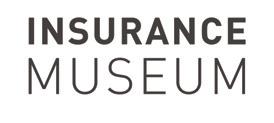
Paul Miller, IM trustee, believes investment in the museum would show great returns for the sector: “A museum would be a fantastic way to attract new talent into the insurance profession. My belief is that any young person can identify a career path in insurance, based on their interests and abilities.
“The opportunities in insurance for young people are endless but are still unknown to many. By telling historical insurance stories to a wide audience, I believe the IM will increase the number of young people making a conscious decision to join the market.”
Benge agrees: “About a third of young people have decided what career they want to go into by age seven, and research suggests children at that age don’t generally consider insurance, unless they have a family member who works in the sector. Mainly because they don’t know what insurance is. To most people, insurance is about pets, cars and houses. If we start talking to the young about the impact insurance has on art, space exploration or the environment, then we’ll get their interest. And the best way to do this is through the educational resources and stories we can share, through the museum.”
So, how can the sector help support the museum? Howard explains it is about engagement but ultimately, it’s also about money.
“We really need senior management to support the idea with significant donations towards funding for the museum or by sponsoring specific galleries. In addition, CII members get a 20% discount off their membership and can subscribe to our newsletter for regular updates.”
To find out how you can support the IM, visit: www.insurance. museum/support-us ●
Sarah Begley of OB Brand Consulting



To find out more, contact your local institute’s President. You’ll find their contact details here: cii.co.uk/membership/local-institutes

Joining your local institute’s council can be challenging, exciting and rewarding. It creates opportunities to voice your opinions on events and topics that will shape your institute’s current and future activities.





Simon Webster provides members with a handy summary of what CPD is and how the CII helps you complete it
With Q2 of 2024 already upon us, now is the perfect time to consider what continuing professional development (CPD) you are undertaking, together with how to record and evidence this.
CPD is a common requirement for qualified members of professional bodies and in some instances, a regulatory requirement. It reflects the fact that, in today’s fast-changing world, knowledge gained through qualifications quickly dates and, if you are to remain competent, you must continue to develop and enhance your knowledge.
CPD helps ensure that, as a CII qualified member, you have the knowledge and skills necessary to succeed in a competitive market. It helps you to:
● Build public confidence and credibility.
● Adapt positively to change by continuously updating skills.
● Support any career goals by focusing on relevant training and development.
● Be more productive and efficient by reflecting on learning and highlighting gaps in knowledge and experience, and plan action accordingly.
The CII CPD scheme provides a practical framework for ensuring development is addressed in a structured way to meet your personal needs, regulatory requirements
(where appropriate), the needs of your employer and the requirements of the CII as a Chartered professional body. All CII qualified members need to:
● Complete a minimum of 35 hours’ compulsory CPD in a 12-month period.
● Of which at least 21 hours must be structured CPD.
Visit www.cii.co.uk/learning/cpd to
find out more about CPD. There we explain what you need to do when recording CPD, including:
● Show the activities undertaken.
● Show whether it was structured or unstructured CPD.
The following all provide gateways to CPD; visit www.cii.co.uk/membership/career to get started.
● CPD events: Continue your learning and enhance your knowledge by attending some of our many local institutes’ CPD events, in-person or through our webinars at CII Digital.
● Career development: Explore our Professional Map, the competency framework and career development tool that helps you identify training needs and prepare for appraisals. Or check out FutureMe for training that can help propel your career forwards.
● Read, listen and browse: Read our member magazine The Journal, listen to our current podcast from The Journal and browse our latest good practice guides, technical papers and e-library to further your knowledge.
● Show the hours recorded against each activity.
● Provide a 'reflective' statement of outcomes, for example: ‘Did the activity meet my learning needs?’
We also provide more information, including:
● Submitting your CPD record.
● Download an example CPD activity.
● Download a blank CPD record.
When you are ready, head over to our CPD tool to help you plan and record your activity – simply login with your CII credentials at www.cpdscheme.cii.co.uk.
For those already familiar with the recording tool, there have been two recent enhancements to it:
1 It now allows you to select your CPD year to run concurrently with the calendar year/financial year/your firm’s development year/the same CPD year as you have with another professional body, etc.
2 You can now tag a specific piece of CPD as a specialism in ‘ethics’ –particularly useful in relation to IDD, pensions transfers and ethics.
CPD is about far more than simply ticking a box; it can help make you a better equipped professional. Consider your approach now to make the most of what you can achieve this year. ●
Simon Webster ismembership marketing manager at the CII
This set of questions, courtesy of online CII training package Insurance Assess, will test your knowledge of relevant learning topics. Answers are at the bottom
QUESTION 1
Which of these perils are most suitable to be reinsured on a catastrophe excess of loss cover basis?
Fire and associated contingencies
Social claims such as riot and malicious damage
Theft and attempted theft
Natural disasters such as windstorm, flood and earthquake
QUESTION 2
Between 75% and 96% of marine accidents can be traced to which of these causes?
Bad weather
Collisions
Human error
the sea
QUESTION 3
Which area of the world writes the greatest amount of marine insurance premium income?
Asia
Europe
Latin America
North America
QUESTION 4
Which of these organisations insure the majority of shipowners’ liability risks?
Fixed price clubs
Marine Lloyd's syndicates
Mutual protection and indemnity clubs
Specialist London insurance companies
QUESTION 5
Which of statement best describes the Consumer Duty Principle 12? A firm must act…
In good faith towards retail customers
In the best interests of a retail customer
To deliver the best outcomes for retail customers
To deliver good outcomes for retail customers
QUESTION 6
Which of these statements about indirect discrimination is true?
The claimant must explain the reason the provision, criterion or practice caused the disadvantage suffered
The claimant must prove that the disadvantage suffered is related to the protected characteristic
Indirect discrimination relates to discrimination against characteristics which are not protected by the Equality Act
Indirect discrimination can be justified by an employer if it is a proportionate means of achieving a legitimate aim
QUESTION 7
Which type of marine unit would most likely be used to extract oil discovered in a small oil field, during an exploratory well drill?
A fixed production system
A floating production system
A jack-up rig
A semi-submersible unit
QUESTION 8
Which of the following does not form part of the new Consumer Duty?
A consumer outcome based on treating customers fairly
A consumer principle
A set of three cross-cutting rules
Four outcomes setting expectation on cultures and behaviours
QUESTION 9
In recruitment, which activity is lawful when endeavouring to increase diversity in the workforce?
Affirmative action
Positive action
Positive discrimination
QUESTION 10
The Consumer Insurance (Disclosure and Representations) Act 2012 applies in which of these marine insurance situations?
Select all applicable answers.
For all shipowners
For canal boat owners for personal use
For cargo owners for commercial hire
For the owners of yachts for personal use
Membership expands networks and creates new opportunities
Membership conveys professional recognition and helps build reputations
Membership develops technical expertise faster and accelerates personal growth
Membership is a life-long journey which is relevant at every stage of your career.







